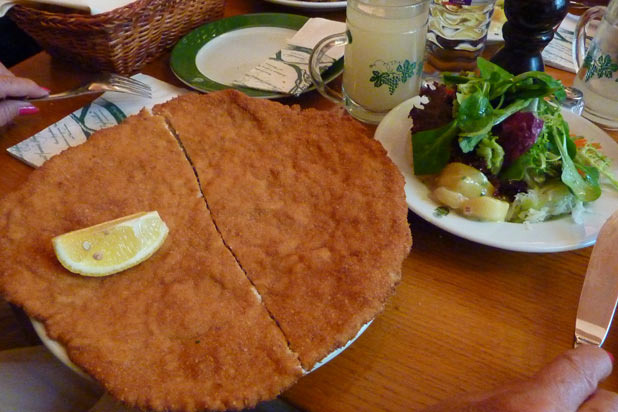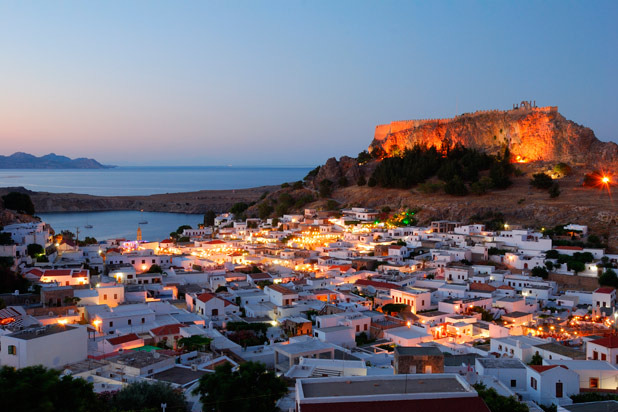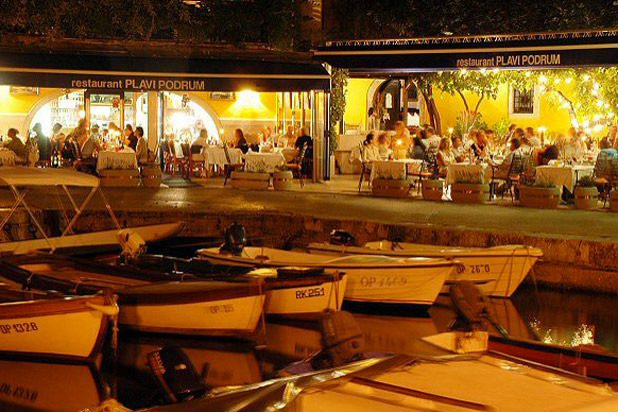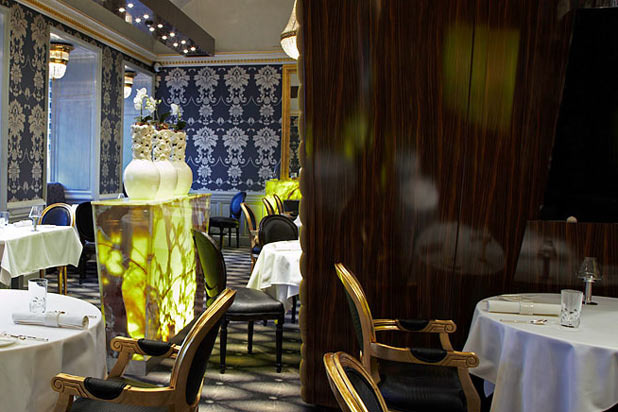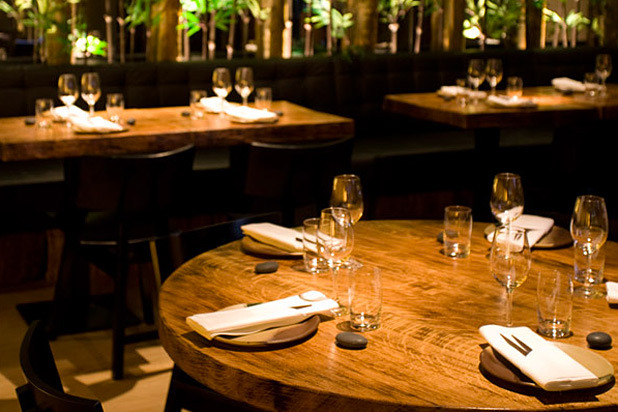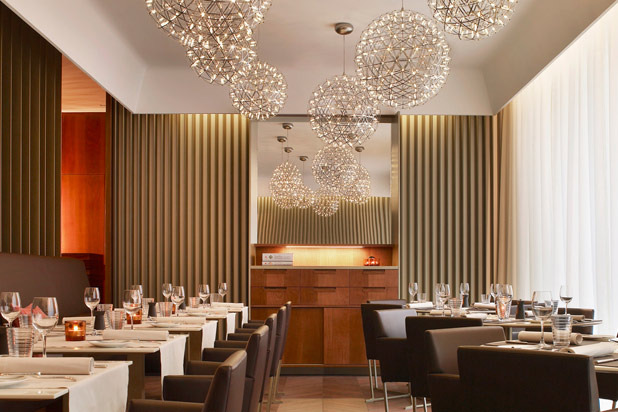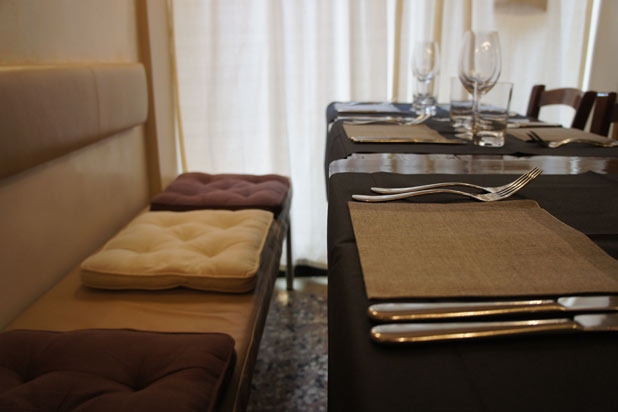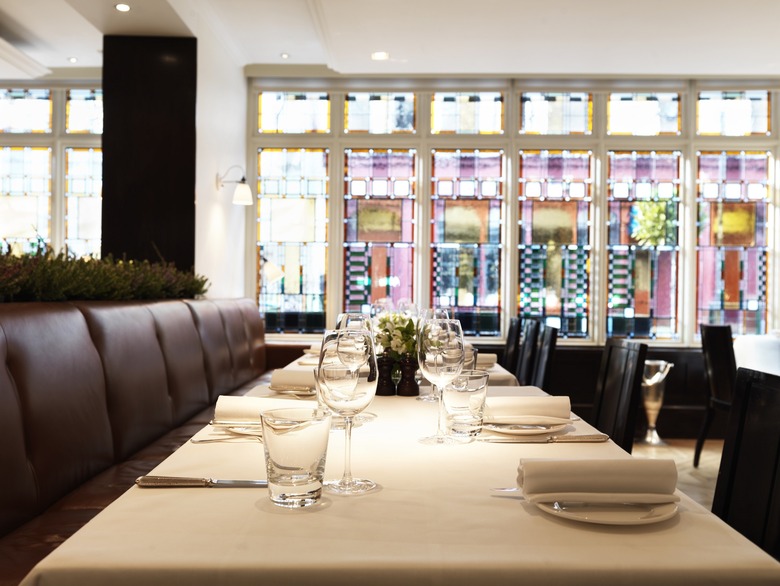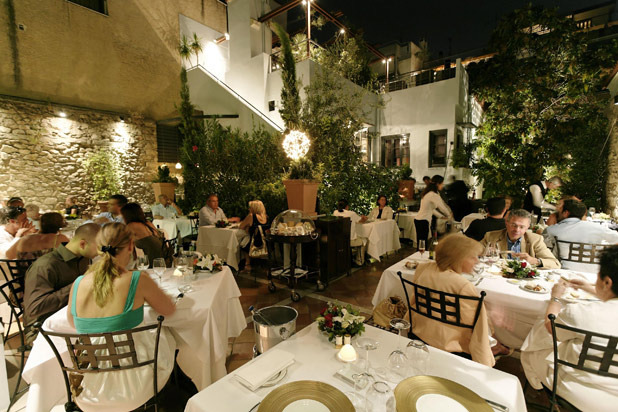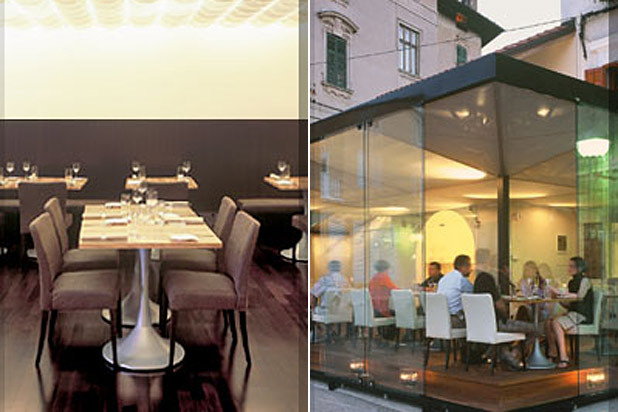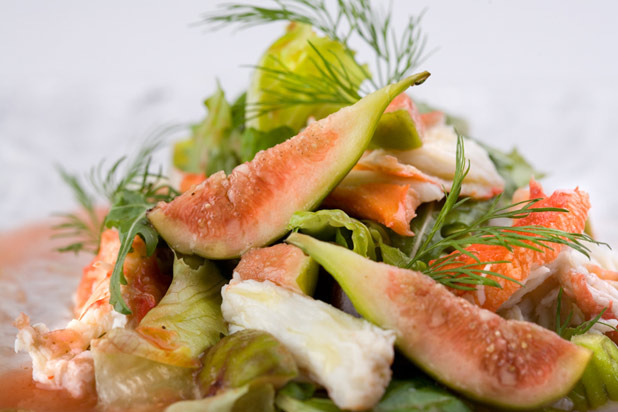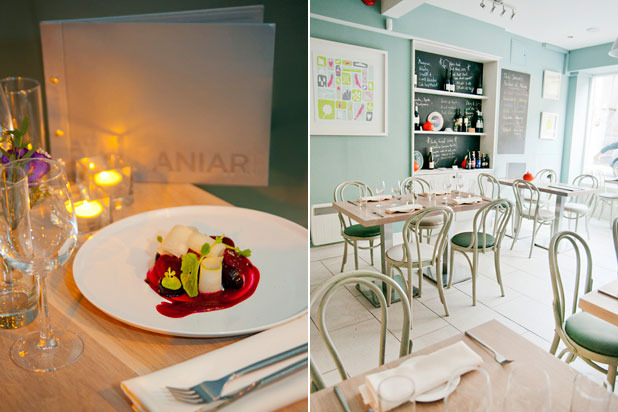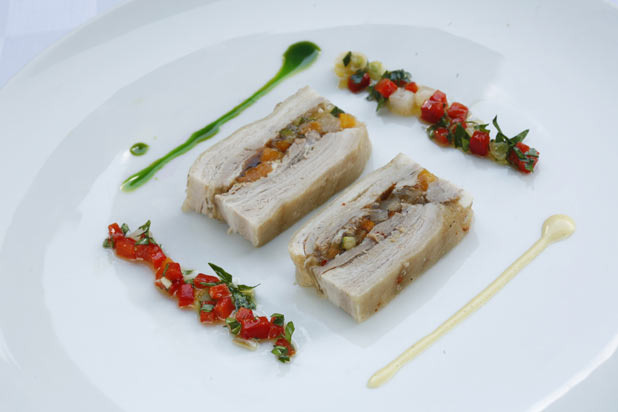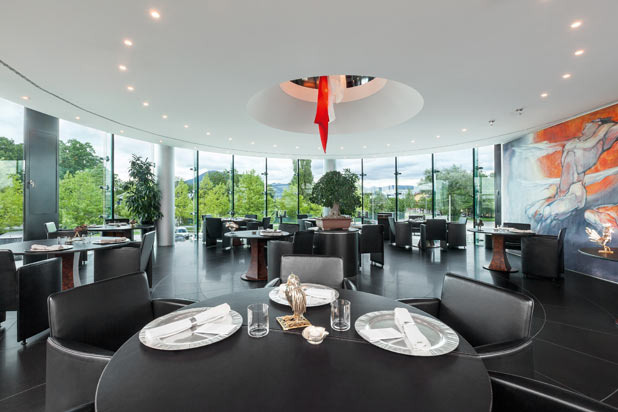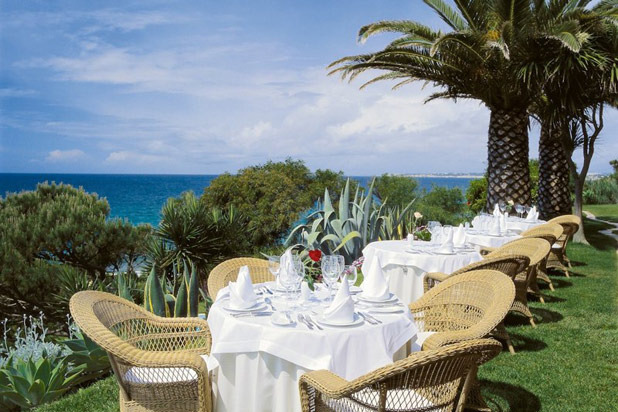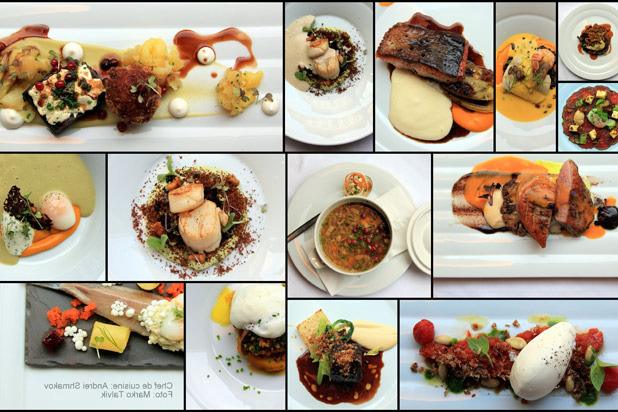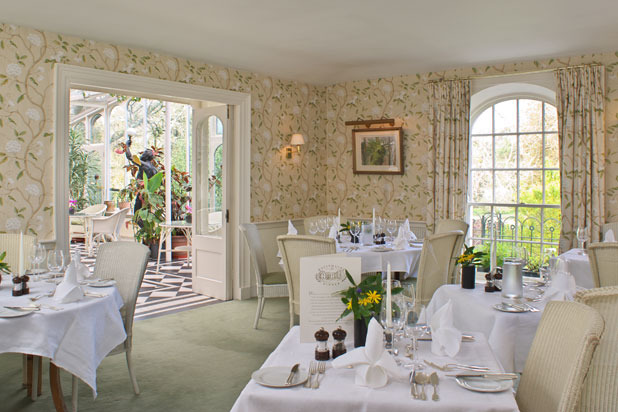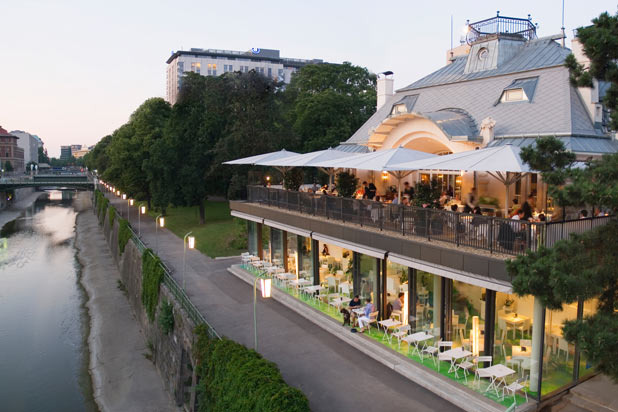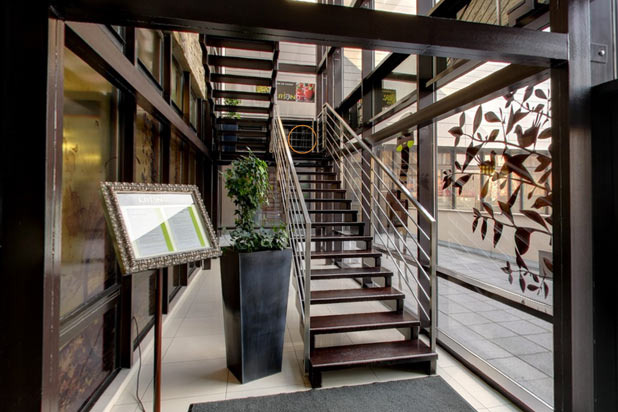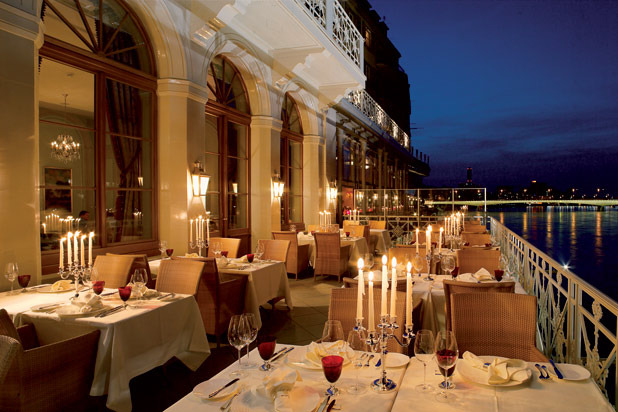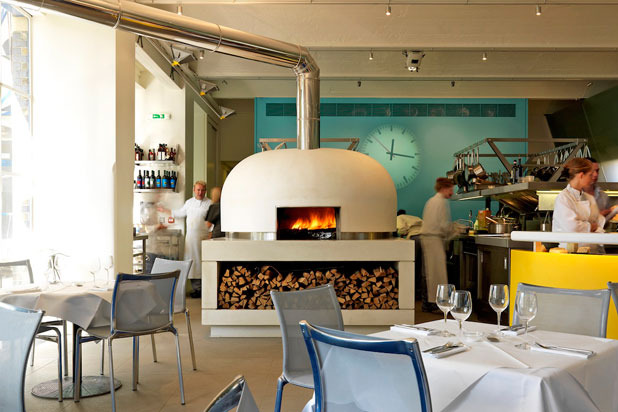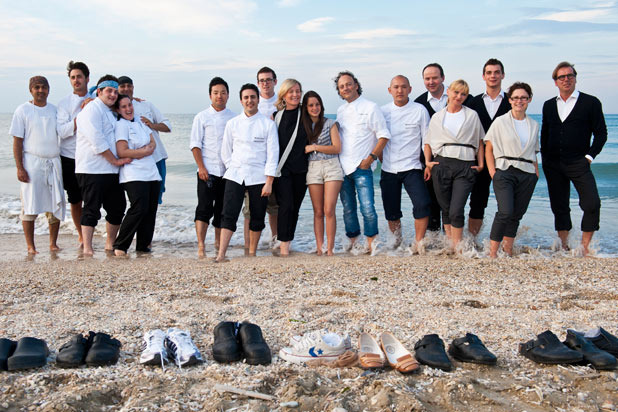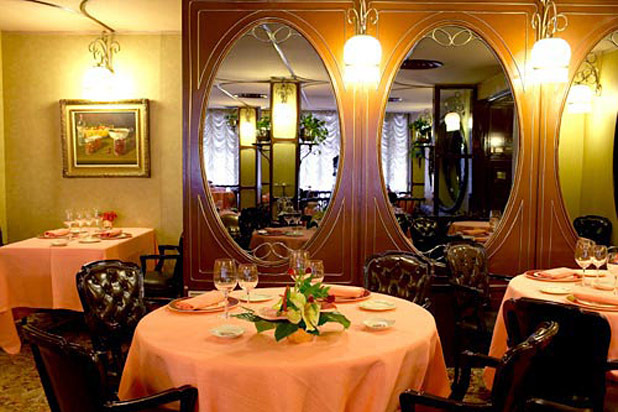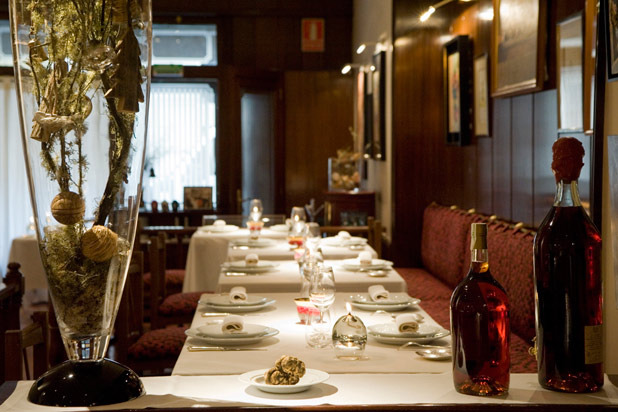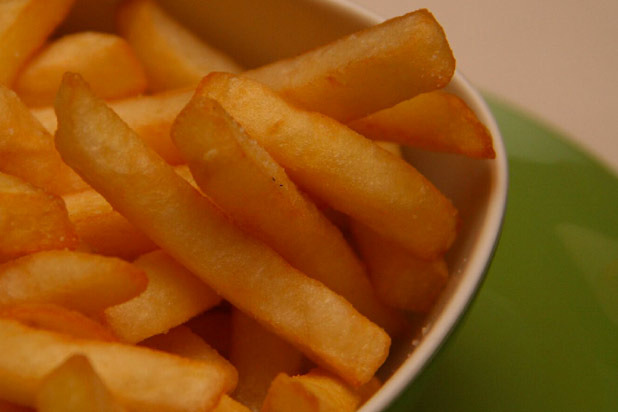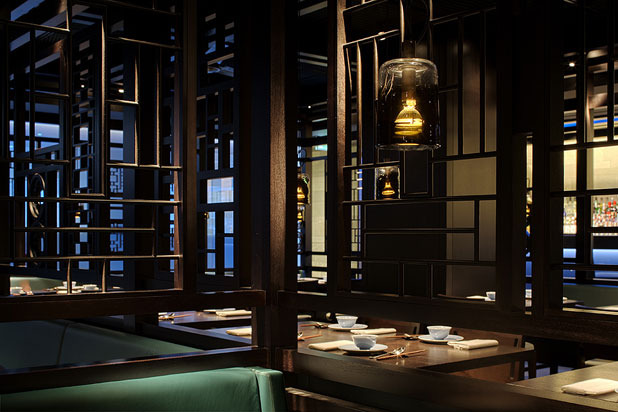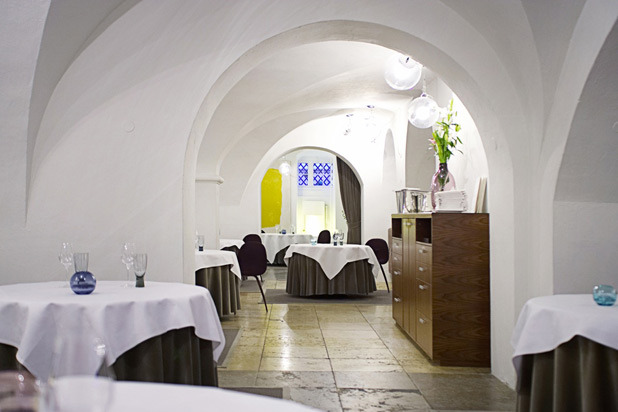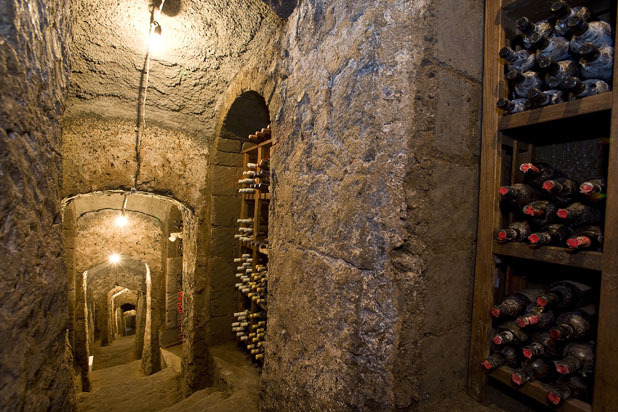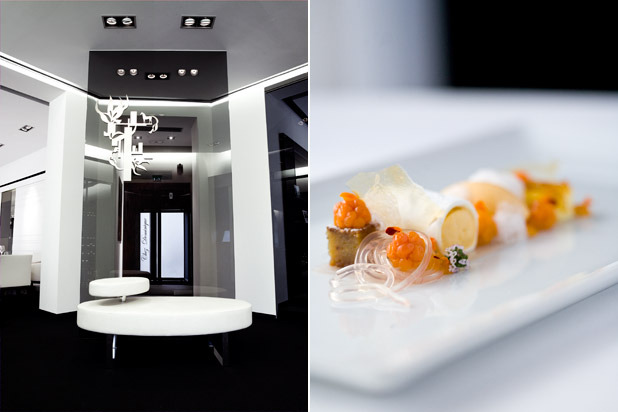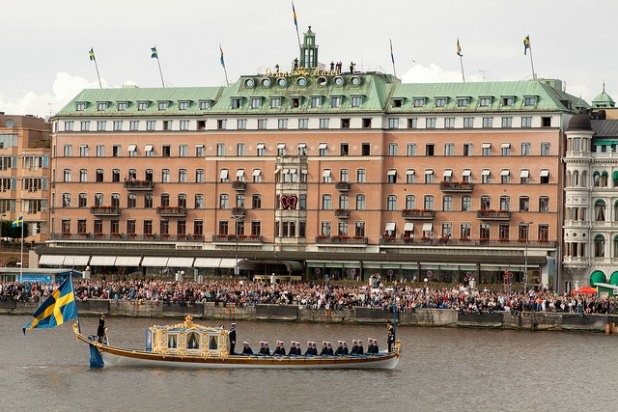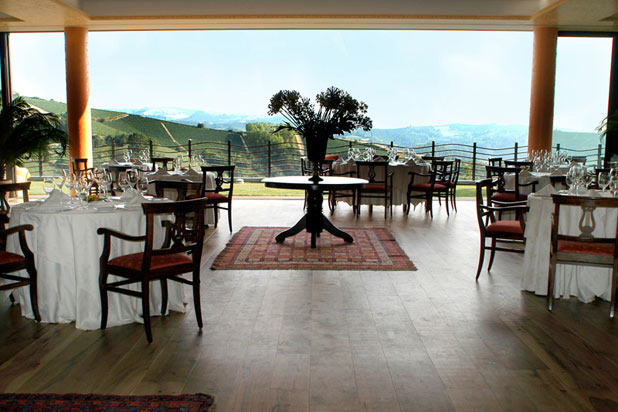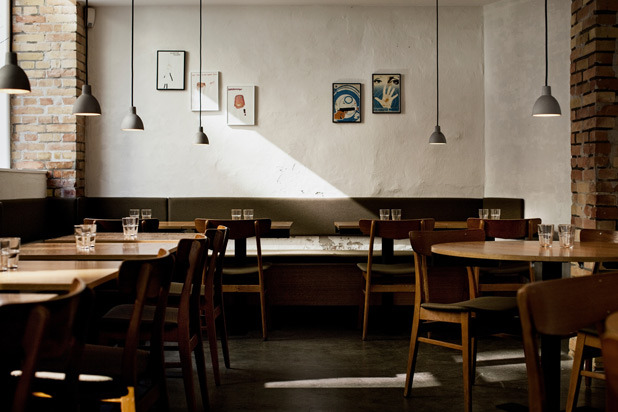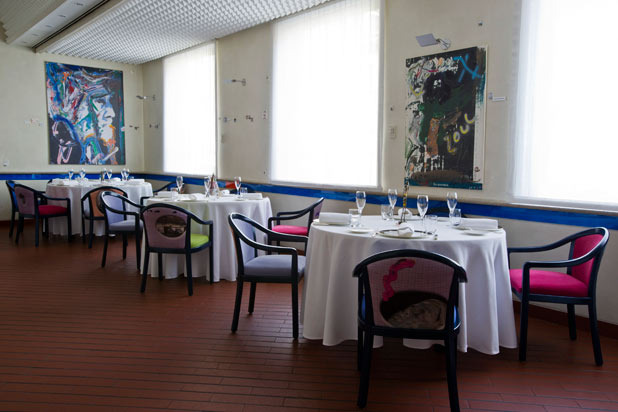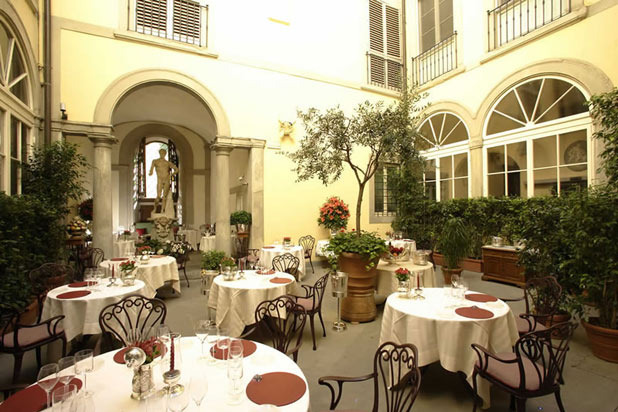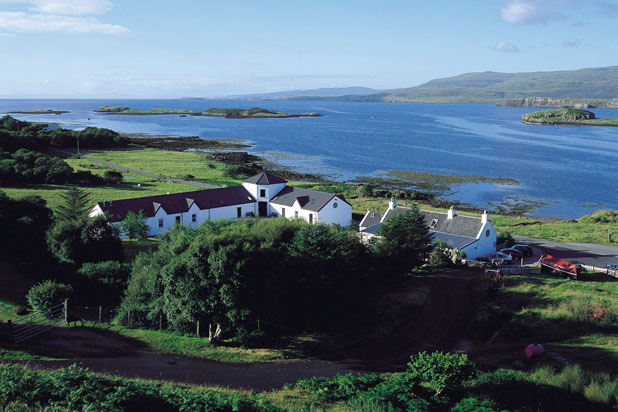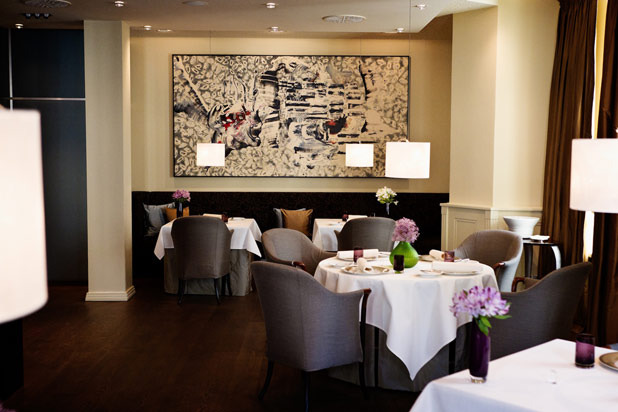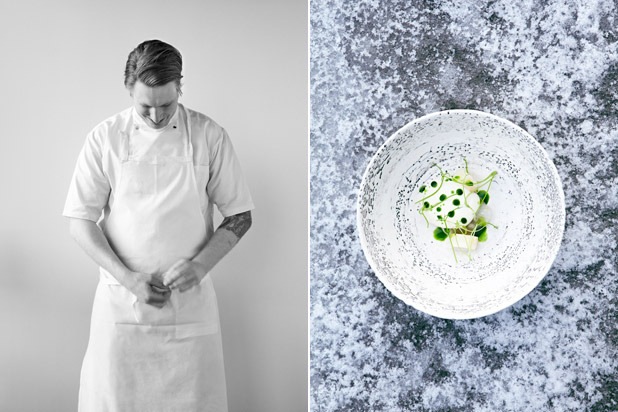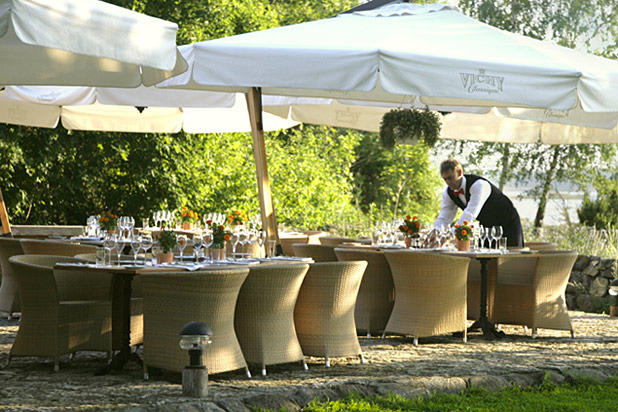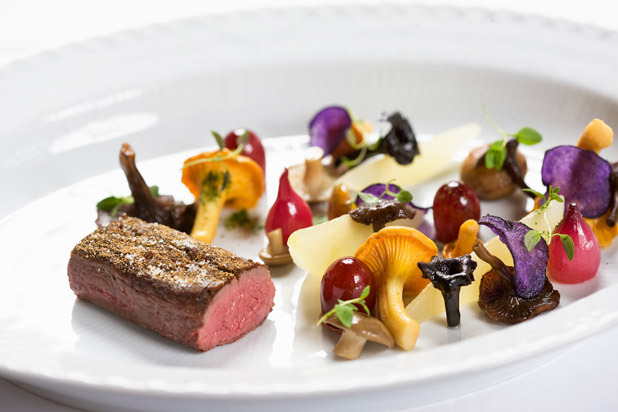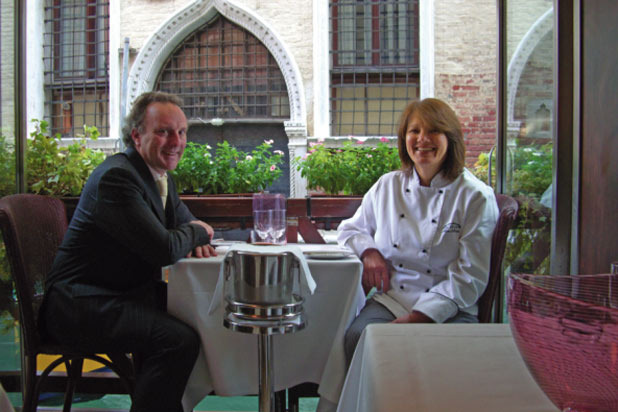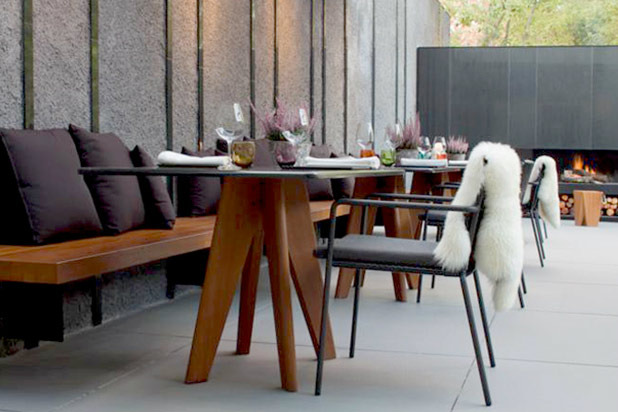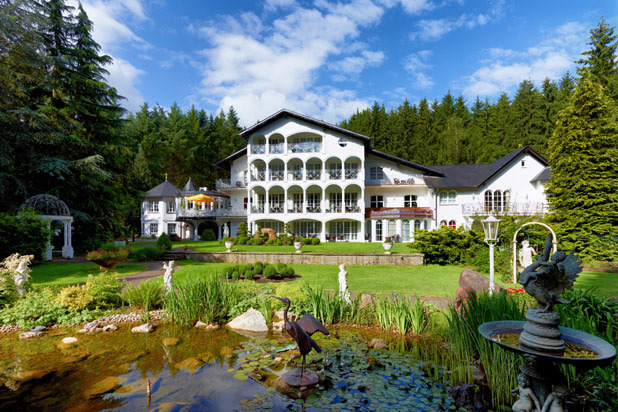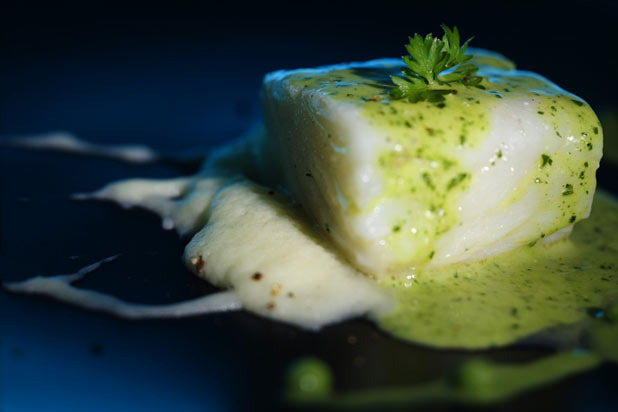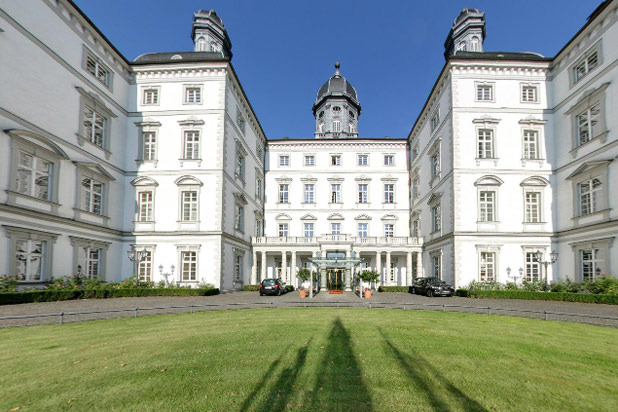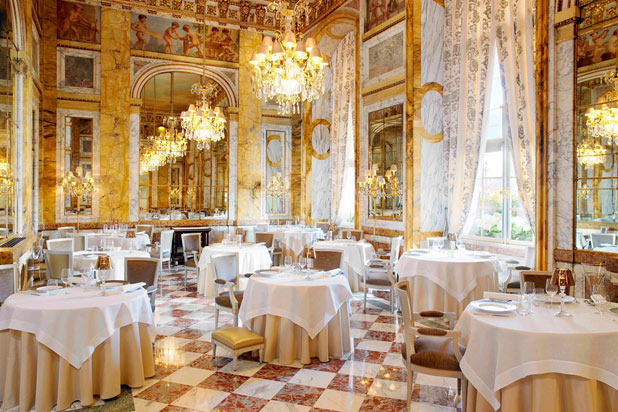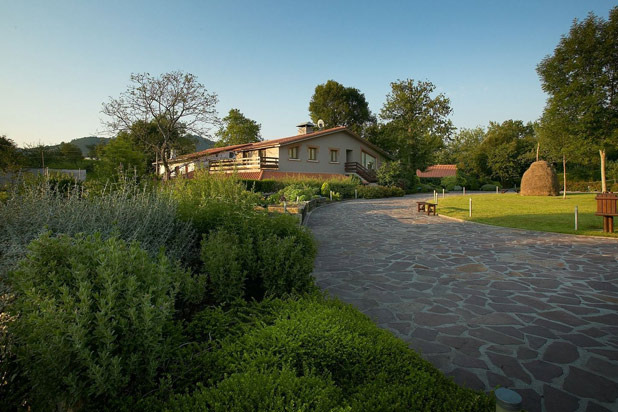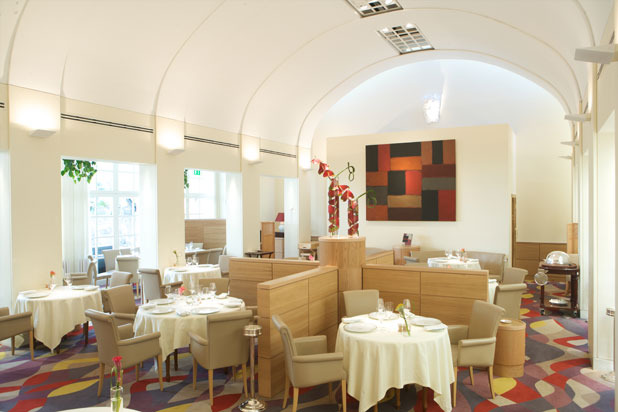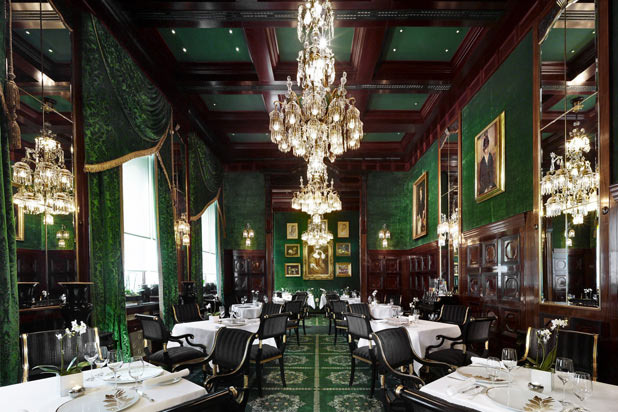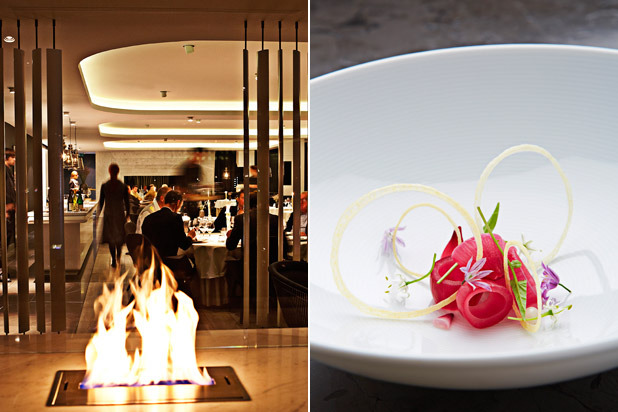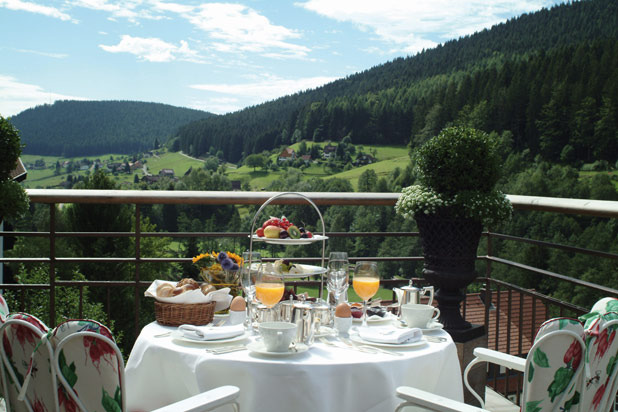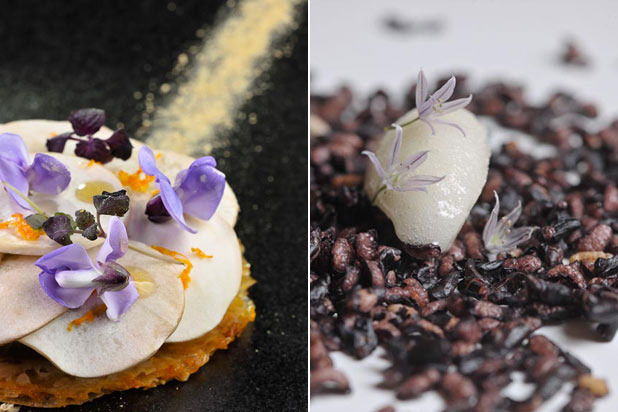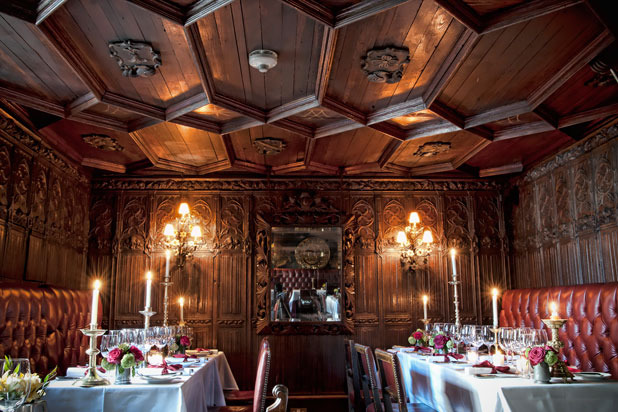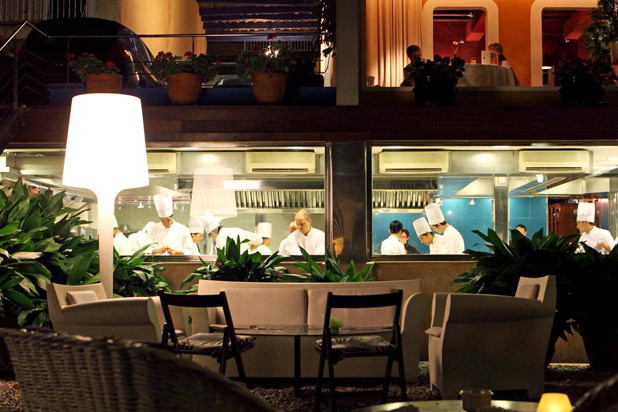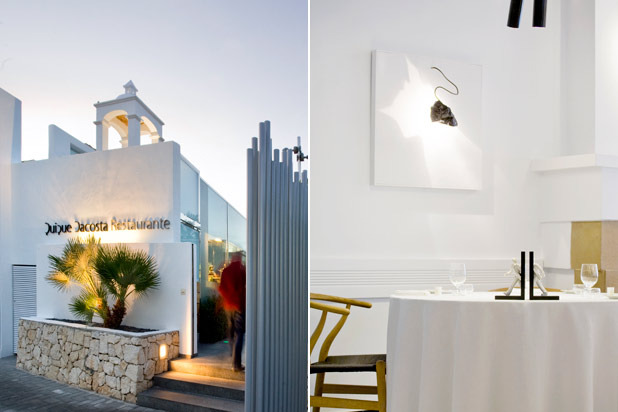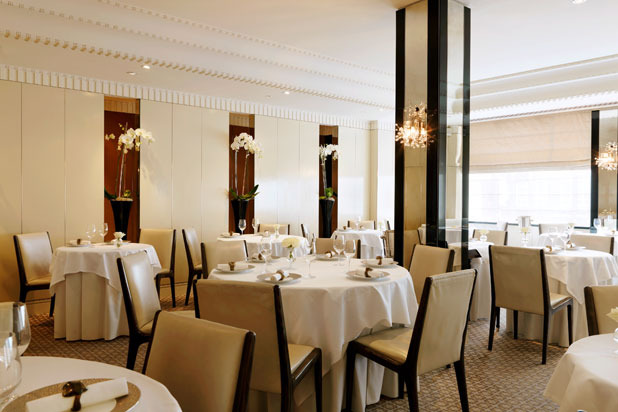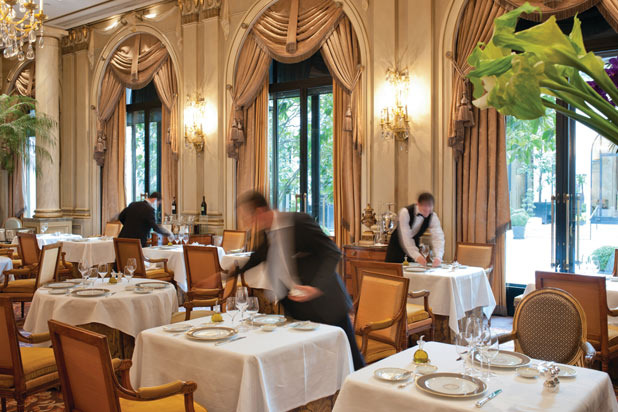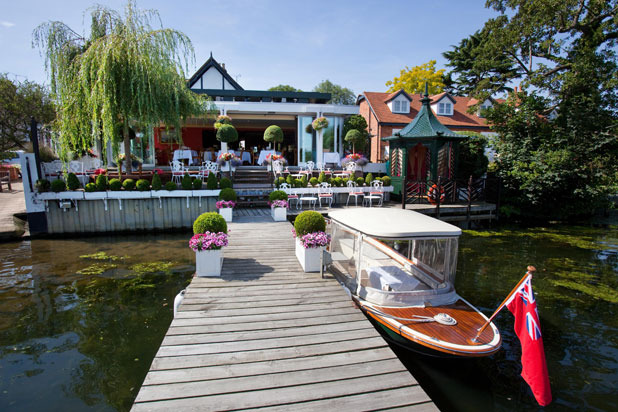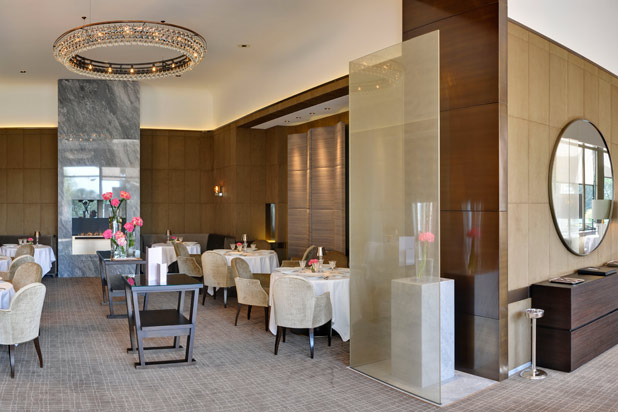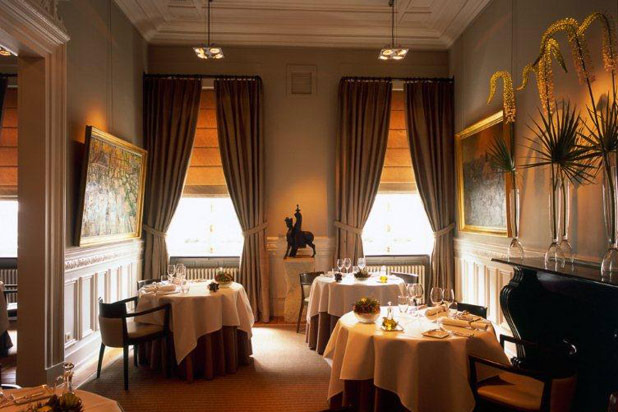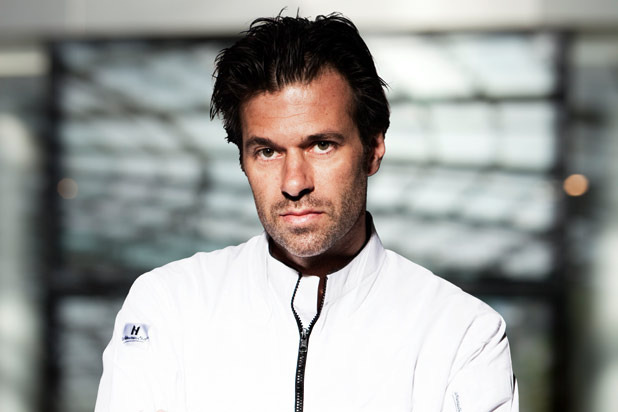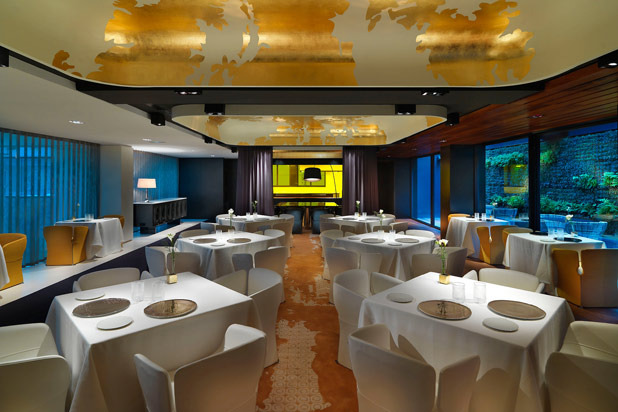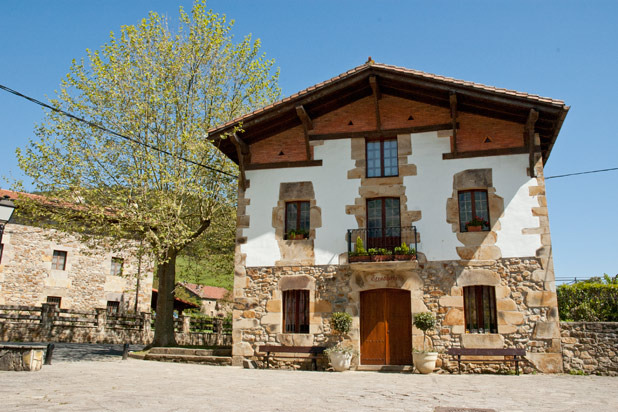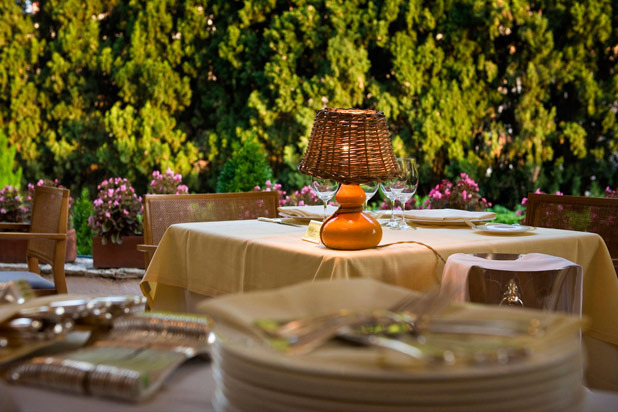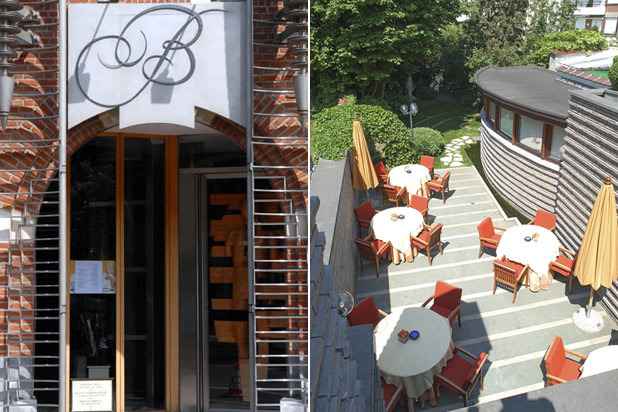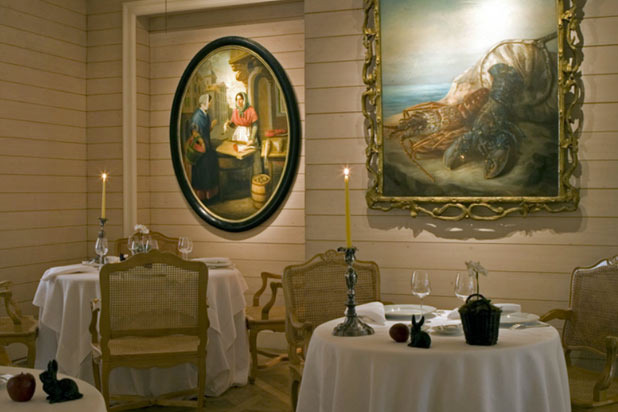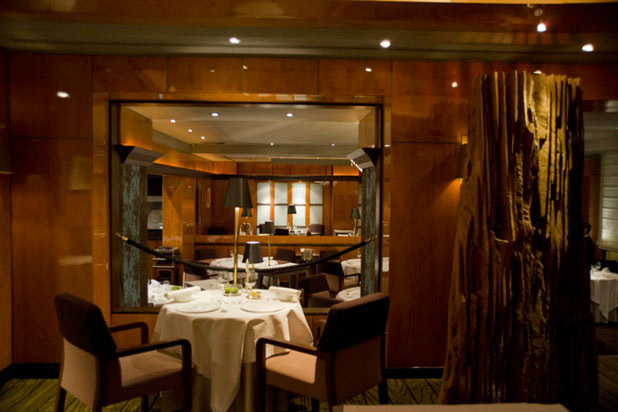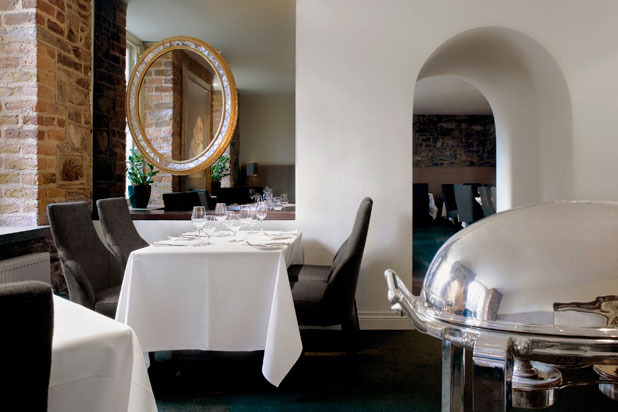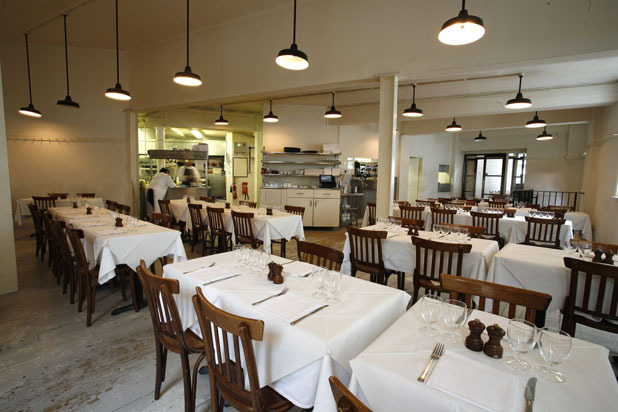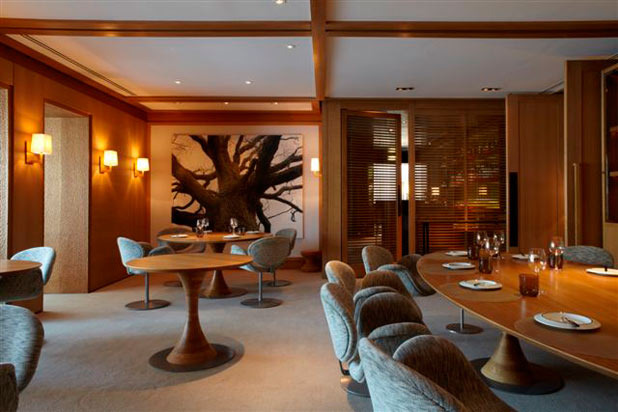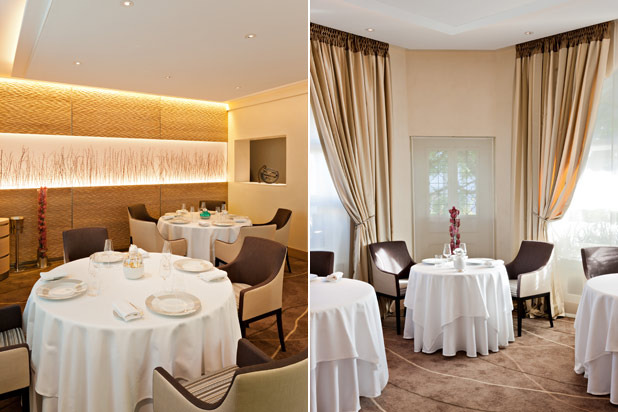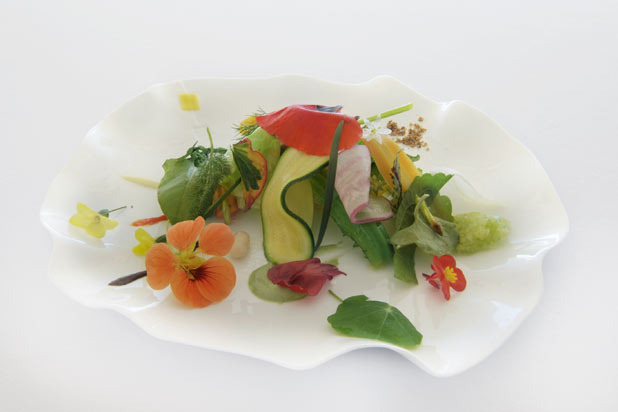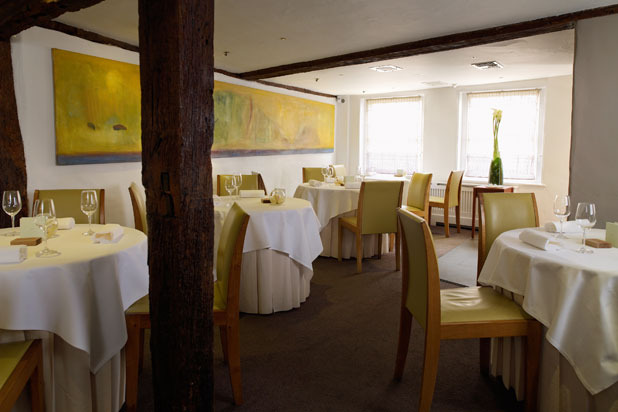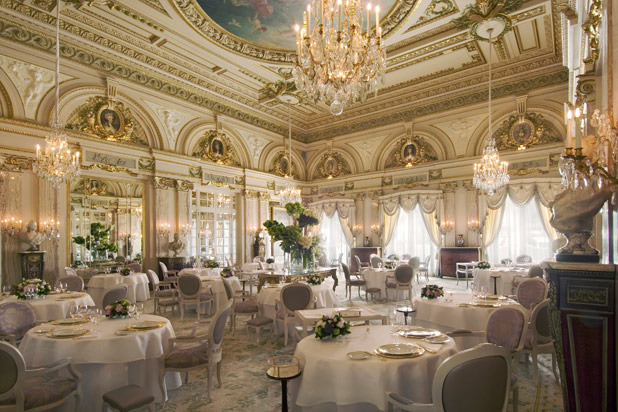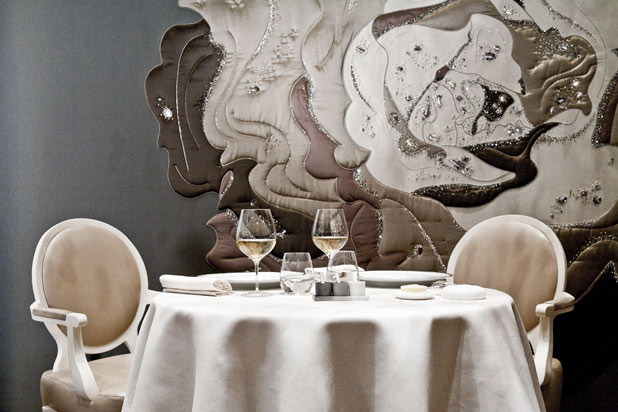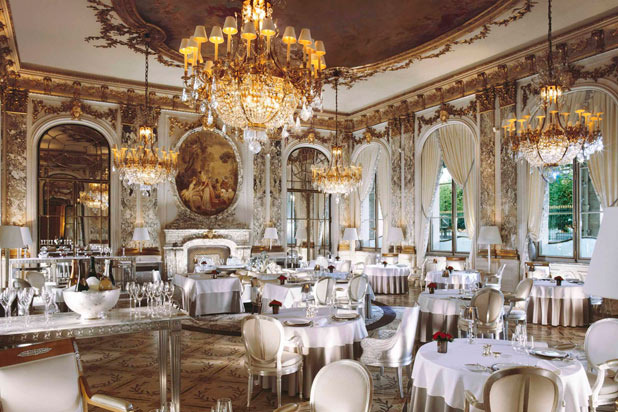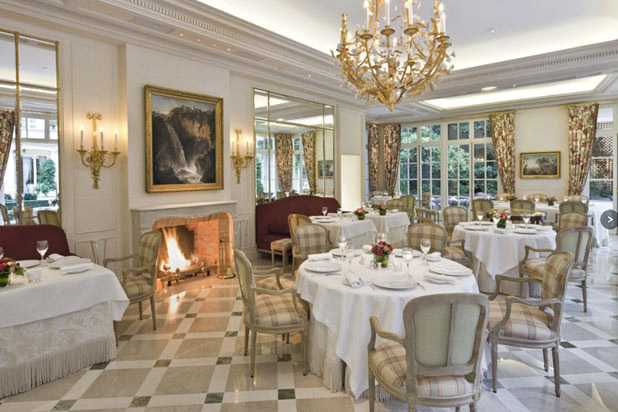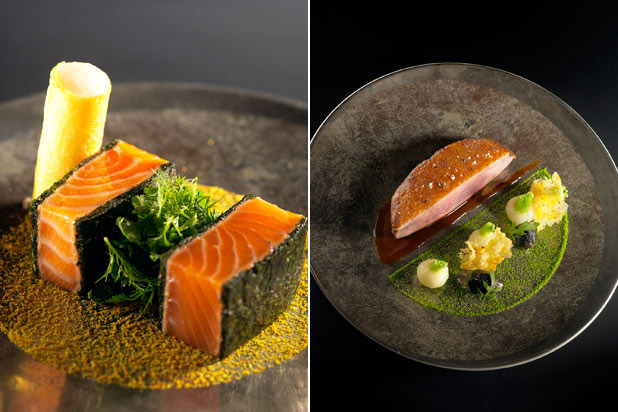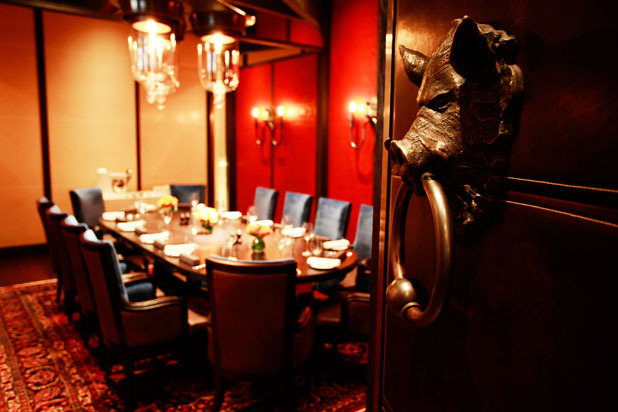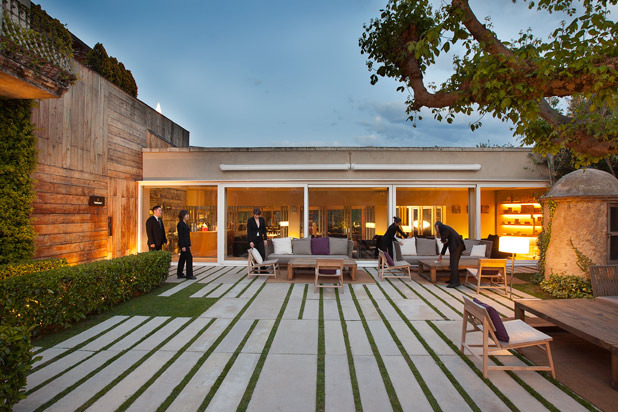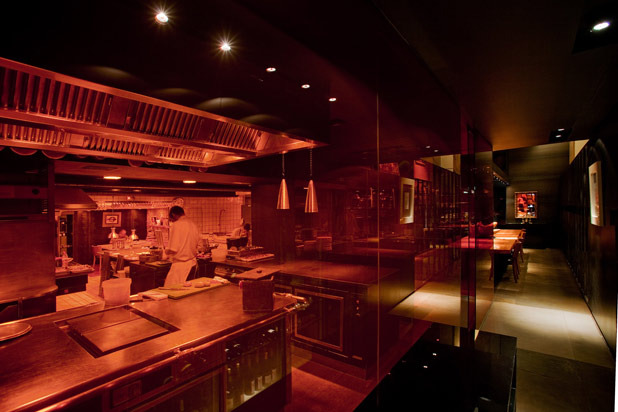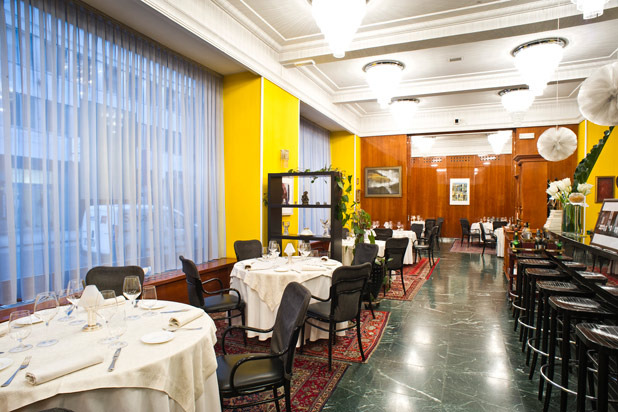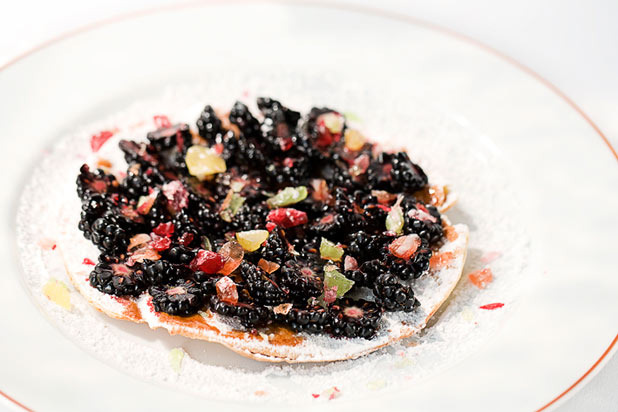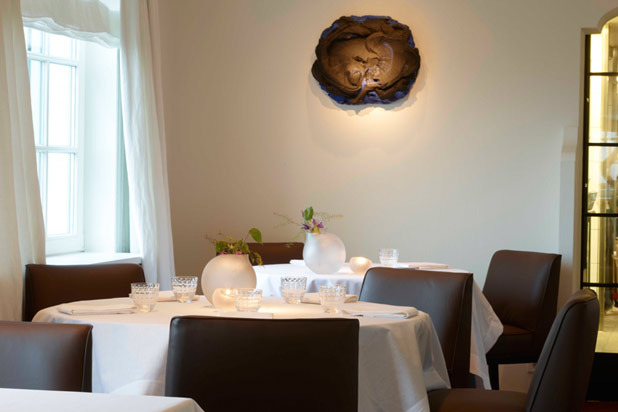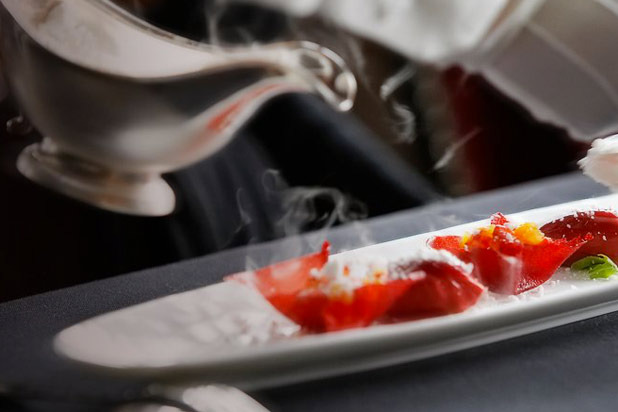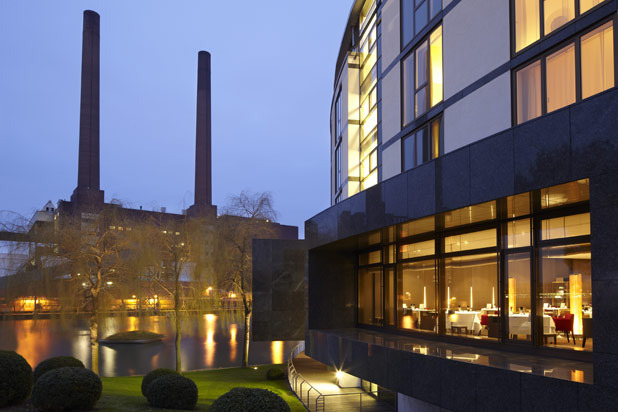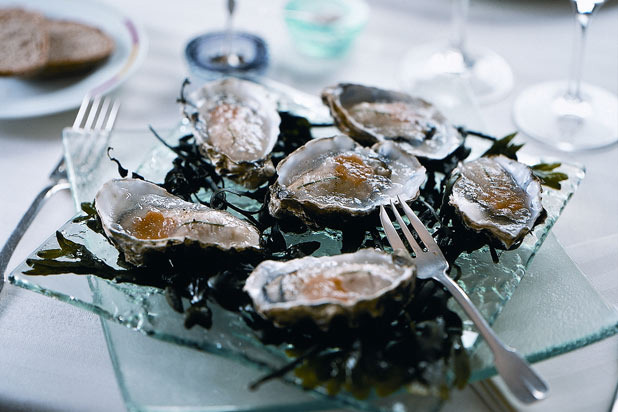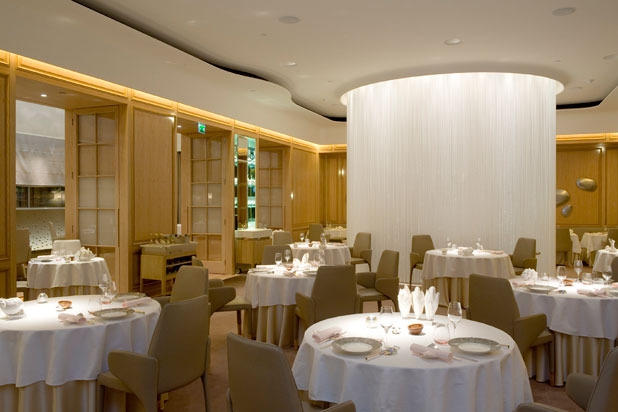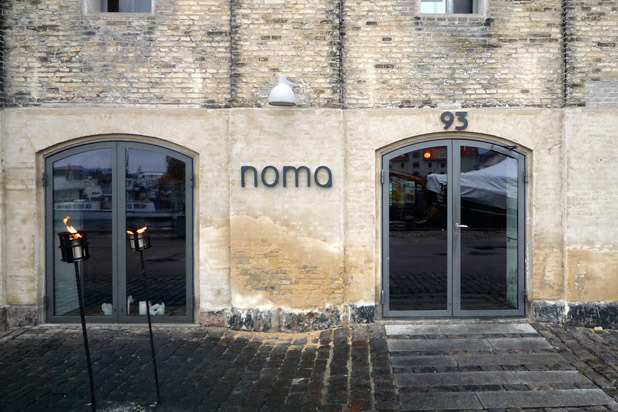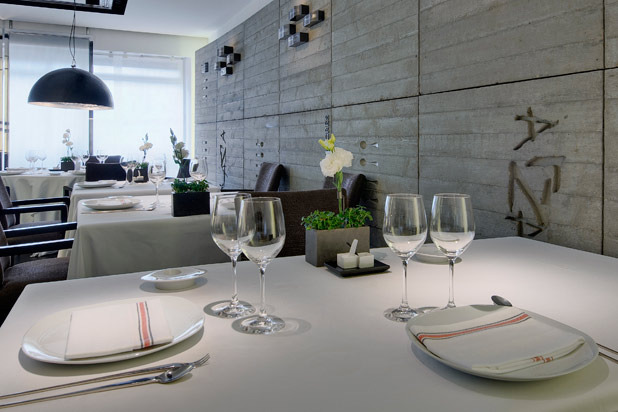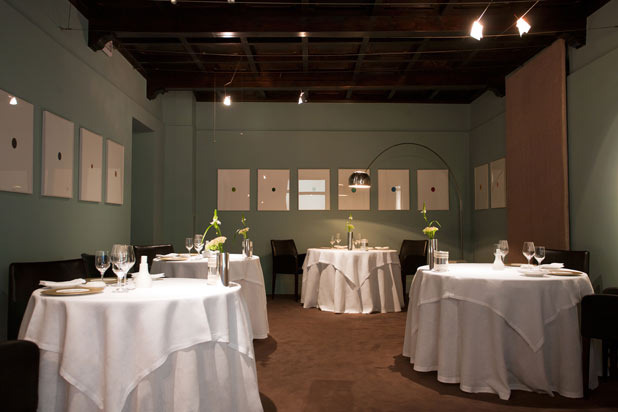101 Best Restaurants In Europe Slideshow
For over 100 years, Figlmüller has served up traditional Viennese dishes at the family-run restaurant just behind St. Stephen's Cathedral. Not to be missed here is the resaurant's original rendition of wienerschnitzel, a thin cut of pork tenderloin that is pounded, coated in egg, flour, and breadcrumbs from so-called Austrian emperor rolls, and then fried for 30 seconds, yielding a golden, crispy, foot-long schnitzel that hangs off the plate; eat it with one of 12 salads offered, like Viennese potato salad.
100. Mavrikos (Lindos, Rhodes)
The family-run Mavrikos has been serving traditional Greek comfort food in the beach town of Lindos, on the southwestern coast of Rhodes, for more than 70 years. The likes of Barbra Streisand and King Abdullah of Jordan have dined at this attractive restaurant in an arched, Greek-style building in the main plateia (town square), enjoying Dimitri Mavrikos' meze plates that include such fare as calamari in beet and saffron sauce, grilled octopus, and smoked manouri cheese with pine nuts and basil.
99. Plavi Podrum (Volosko, Croatia)
The oldest restaurant in the tiny fishing village of Volosko, Plavi Podrum is known for its seafood dishes and incorporating regional products like asparagus, truffles, and nettles. The seasonally changing menu includes scampi buzara and polenta with new corn and herbs, wild asparagus and champagne risotto, and chocolate cake and chocolate mousse made from Lindt 72 percent Ecuadorian chocolate and accompanied by orange and homemade chocolate ice cream with red pepper flakes.
98. Onyx (Budapest, Hungary)
The 55-seat Onyx, with its colored walls, ceiling-high suede banquets, and sumptuous leather-backed chairs, is the epitome of elegance. Parents of small children are encouraged to leave them at home, as the culinary journey here can take between three and four hours for those who order the degustation menu. Executive chef Szabina Szulló and sous-chef Tamás Széll work together to develop dishes with varied flavors, like the marinated goose liver with plum, and roasted duck liver with beetroot and green apple. T
97. Fish Market (Reykjavik, Iceland)
Housed in one of the oldest buildings in the Icelandic capital, Fish Market blends Icelandic and Asian elements, from the bamboo and oak décor to the seafood creations handcrafted at the restaurant's basement-level raw bar and open kitchen (which contains Iceland's only robata grill). Chef Hrefna Rósa Jóhannsdóttir Sætran's cuisine is ambitious and well-crafted. Sample her lobster soup with roasted coconut flakes, coconut milk, mussels, and mandarin orange; smoked Icelandic pork ribs with star anise, cardamom, and homemade barbecue sauce; grilled skewered monkfish with butternut purée, corn and pepper salsa, and wasabi butter; or, from the sushi bar, the Fish Market Christmas maki roll (involving tuna, salmon, smoked Arctic char, pineapple, cream cheese, chile oil, and sesame seeds). Adventurous diners might want to sample the smoked puffin breast with fig and cumin jam.
96. miX (St. Petersburg, Russia)
As equally modernistic as its home, the W St. Petersburg hotel, Alain Ducasse's restaurant, with décor inspired by Russia's famed Fabergé eggs, focuses on delicate dishes with classic French preparations. Though diners can order from the Alain Ducasse Classics menu, a collection of dishes that have made the French chef famous, they can also try new dishes created for St. Petersburg's miX, like Kamchatka crab and chestnut bisque, champagne-braised halibut, and rabbit à la royale.
95. Ristorante Del Cambio (Turin, Italy)
This place glows with history and tradition. First opened in 1757, it has been the most elegant special-occasion restaurant in Turin ever since. Its most famous customer, through the mid-1880s, was the Count Camillo Cavour, one of the fathers of modern Italy, and his favorite table is preserved, complete with his reading glasses, as if he had just excused himself to visit il bagno. The chef is young and brings brightness and energy to the menu, but he still prepares many of the specialties the restaurant's customers have been enjoying for generations — a textbook vitello tonnato, risotto drizzled with roasting-pan juices, classic agnolotti, a grand fritto misto (assorted fried vegetables, organ meats, and other foods), etc. There are plenty of impressive wines, especially from Piemonte. The check at Ristorante Del Cambio will be impressive, too.
94. Selene (Pyrgos, Santorini, Greece)
The aim of Selene, to promote local products and cuisine, has remained the same since it opened 26 years ago in Fira, on the island of Santorini. In the decades since, Selene has moved to the center of Pyrgos and is perched on one of the highest points on the island, affording amazing views from the dining room. Located adjacent to some of the island's famous vineyards and farmland, Selene has a new chef, Nikos Boukis, but the locally inspired food remains extraordinary. The multicourse dinner includes offerings like clam and sea urchin with lime foam, sea bass and zucchini with garlic and stuffed zucchini flowers, and baklava with Santorini pistachios and baklava ice cream. Since moving to Pyrgos, the restaurant has added a more informal tavern and a folklore museum featuring exhibits on traditional agricultural production. Visitors can indulge in a package that includes wine tasting, a museum tour, cooking class, and dinner.
93. Alle Testiere (Venice, Italy)
This tiny Venetian hideaway, its walls decorated with testiere — headboards — is dedicated to seafood, with well-chosen wines to match. The short menu changes every day, but the kinds of things you are apt to find here include shrimp and raw asparagus salad, bay scallops on the half shell with wisps of orange and onion, zotoeti (the tiniest squid you can imagine) in a sauce improbably but deliciously accented with cinnamon, spaghetti with bavarasse clams, and four or five kinds of simple grilled fish.
92. Quo Vadis (London)
Jeremy Lee has long been one of the best no-nonsense, seasonally aware cooks in London, but in his berth at the Blueprint Café atop the city's Design Museum, he never got the attention he deserved. Now he's in the middle of Soho, at the old-line (but newly revivified) Quo Vadis. His wonderfully British menu ranges from (at this time of year) smoked eel and horseradish sandwich and crab with mayonnaise to whole mackerel with pickled gooseberries and "grouse & co". The room is pretty, the cooking is just right, and the wines are well-chosen.
91. Spondi (Athens, Greece)
Since Apostolos Trastelis opened Spondi in 1996, it has been the talk of the town. Located about 100 yards behind the Parthenon, this two-Michelin-starred restaurant is impeccably furnished, and the dining room features fine touches like Baccarat crystal glasses and Christofle cheese and dessert trolleys. The cuisine is the star attraction, though. The seasonally changing menu includes such appetizers as foie gras baton with orange and xocopili chocolate and crab in mint jelly with grated cauliflower and Granny Smith apples, and mains like milk-fed roasted lamb in herb cocotte with candied lemon paste served with eggplant-coriander polenta and garlic.
90. Le Mandrac (Volosko, Croatia)
Chef Deniz Zembos "slow food" is served by candlelight on the outdoor terrace of Le Mandrac in Volosko, a fishermans village in Opatija, on the Istrian peninsula. The menu, which features 12 dishes, changes based on the seasons, but the daily tasting menu is the ideal way to sample Zembos culinary genius. This nine-course feast includes dishes like scampi sashimi with warm wild fennel mousse and malvasia foam, smoked scallops with polenta and leek and curry foam, and white chocolate mousse and lemon tart with ice cream.
89. Syr (Moscow)
Arguably the most famous Italian restaurant in Moscow, Syr has been popular since its opening in 2001. It's not surprising that Syr, which means "cheese" in Russian, has a décor and menu inspired by that dairy product, from the yellow walls with small windows and a labyrinth-like layout to yellow circular menus reminiscent of cheese wheels and a menu brimming with cheese options. Head chef Mirko Dzagiev also serves hearty Italian fare like lobster salad with peaches and toasted pistachios and octopus carpaccio with celery salad and seafood.
88. Aniar Restaurant (Galway, Ireland)
Run by JP McMahon and Drigín Gaffey, the duo behind Galway's Cava Spanish Restaurant and Tapas Bar, Aniar — which just received a coveted Michelin star, one of only a handful in Ireland — menu around the principles of terroir. Chef Enda McEvoy crafts the menu around the seasons, drawing from Galway's bucolic ancient woodland, abundant farmlands, and bountiful shorelines. The à la carte and four-course tasting menu change daily, but items like wild mallard with beetroot, hazelnut, spruce, and apple; and rosehip parfait with elderflower jelly and honeycomb make regular appearances.
87. Csalogány 26 (Budapest, Hungary)
The tiny Csalogány 26 has a simple interior of delicate wooden chairs, white tablecloths, and cream walls, but the food that grabs diners' attention.The seasonal menus composed by chef Balázs Peth offers a range of international flavors like the duck liver with bulgur and Scottish salmon with caper risotto.
86. Ikarus (Salzburg, Austria)
The team at Ikarus plays by its own rules, down to the kitchen crew donning black outfits instead of chef's whites, and checkered pants and black baseball caps emblazoned with Hangar-7 instead of toques. Hangar-7 is a building at Salzburg Airport owned by Dietrich Mateschitz, the founder of energy drink company Red Bull, which includes an airplane collection, art exhibits, and Ikarus. Chef Roland Trettl has been with the restaurant since it opened in 2003, but Ikarus has implemented a guest chef program, bringing in culinary stars from around the world to cook here for a month at a time. Jean-Georges Vongerichten, Spanish chef Xavier Pellicer (who took over the stoves at the Catalonian three-star El Racó de Can Fabes following the death of its founder last year), and German chef Rainer Becker have cooked here. Spanish chef Ramón Freixa helms the kitchen in December.
85. Vila Joya (Albufeira, Portugal)
Overlooking the beach of Praia da Galé, the boutique hotel Vila Joya boasts two Michelin stars for its Vila Joya Restaurant. Austrian chef Dieter Koschina has helmed the kitchen since 1991, creating masterful and memorable haute cuisine using fresh lobster, turbot, and other delicacies from the Atlantic and the Mediterranean, along with fresh produce from local markets. His imaginative specialties include giant prawns with calf's head vinaigrette; duckling with goose liver, lentils, and celery ravioli; and a "hot and cold" composition of Valrhona chocolate.
84. Ribe (Tallinn, Estonia)
Located on Tallinn's Vene Road, known as the country's restaurant street, Ribe has set itself apart from its neighbors since opening its doors in 2007. Head chef Andrei Shmakov's menu changes seasonally and is enhanced with a wine list of 120 Old World labels. Diners have recently been treated to such dishes as herb-crusted lamb neck confit with eggplant purée, fried potatoes, goat milk yogurt cream, and port jus, and a dessert of apricot panna cotta with peppermint jelly, apricot sauce, and baked apricots.
83. The Restaurant at Ballymaloe House (Shanagarry, Ireland)
It might be an exaggeration to say that good modern-day Irish cooking was born at this delightful country hotel, but it wouldn't be much of one. It was here, in 1964, that Myrtle Allen, wife of a local orchardist, opened a small dining room serving solid home cooking made with produce from her property and neighboring farms and seafood from the small fishing a few miles away. She didn't try to be fancy or French (in fact, she later ran a restaurant for several years in Paris bringing Irish cooking to the French), just honest and consistent, and she ended up inspiring two generations of Irish cooks, purveyors, and artisan producers — the core of the thriving Irish food scene today. The restaurant and hotel have flourished and grown, and today those who make the pilgrimage to this corner of East Cork will feast on such fare as onion and thyme soup, smoked salmon rillettes with pickled cucumbers, poached Ballycotton monkfish with scallops, Gubbeen ham braised in white wine, Irish farmhouse cheeses, and seasonal fruit tarts.
82. Fishy Fishy (Kinsale, Ireland)
There's nothing fishy about the food at Fishy Fishy, which procures all its seafood — from cod, John Dory, and haddock to lobster, squid, and crab — locally and serves it pier-side overlooking Kinsale Harbour. Preparations are simple and the quality of the raw materials is impeccable. Run by husband-and-wife team Martin and Marie Shanahan, Fishy Fishy began as a fish and chip shop with a deli that supplied local catch to area restaurants, then turned into a full-scale restaurant of its own. Fishy Fishy also has a fish market that sells seafood for home preparation and — back to its origins — the Fishy Fishy Chippie, which sells, yes, fish and chips.
81. Steirereck (Vienna, Austria)
Nature is the inspiration for two-Michelin-starred chef Heinz Reitbauer's cuisine, and for the décor at Steirereck. Dishes like char with beeswax and carrot pollen, crayfish with spiced parsnip strudel, wild broccoli with artichoke pith and foie gras, and roast pigeon with parsley, amaranth, millet, and sesame evoke the outdoors in form and freshness of flavor, while the dining room suggests a winter scene, with a neutral palette extending to the light cream walls and fixtures, offset by cushioned red chairs.
80. Liviano Restaurant (Bratislava, Slovakia)
At Liviano, owner-chef Pavel Pospíšil has created a clean-lined dining room using natural materials, like diamond-shaped wooden bar shelves and leather place mats. His innovative approach to Slovak food has earned him praise for such dishes as creamy goose soup with ravioli, venison broth with truffle gnocchi, grilled tuna in honey-ginger sauce, porcini-stuffed chicken with puréed peas, and braised pork cheeks with ginger and kohlrabi.
79. Cheval Blanc (Basel, Switzerland)
The Hôtel des Trois Rois, on the banks of the Rhine in Basel, is one of several establishments that claims to be the oldest continuously operating hotel in Europe (it is mentioned in documents as early as 1681), but there's nothing antique about chef Peter Knogl's two-Michelin-starred cuisine, which runs from foie gras with pineapple and black pepper and fried scampi with trumpet mushrooms and chive sauce to Bresse pigeon with Moroccan flavors and glazed Nantais duckling with fig juice for two. Lukewarm chocolate cake with mango and coconut ice cream is a dessert not to be missed.
78. The River Cafe (London)
Someone once called this "the best Italian restaurant in Europe" — Italy included. That may be an exaggeration, but the refreshingly simple, imaginative but authentic Italian food that has been produced at The River Cafe by Ruth Rogers and (until her untimely death in 2010) Rose Gray since the late 1980s. The noted British architect Sir Richard Rogers — Ruth's husband — has given the place a bright, almost sparkling energy (the room-length counter separating the kitchen from the dining room and the big wood-burning oven in one corner help). Staples on the menu include char-grilled squid with chile flakes and rocket (arugula), and seared Scottish scallops with various accompaniments — and of course the legendary Chocolate Nemesis cake. Among autumnal offerings might be tagliatelle with "first of the season wet walnut sauce" and herb-stuffed whole grouse on bruschetta.
77. Madonnina del Pescatore (Senigallia, Italy)
Moreno Cedroni invented "susci" (pronounced "sushi" in Italian) — his take on the elemental Japanese specialty, involving such dishes as warm sea bass carpaccio with lime purée and raw tuna with iced mustard and toasted almonds. It's hardly surprising, then, that the seafood at his Michelin two-star Madonnina del Pescatore, which he has run with his wife, Mariella, since 1984, is highly innovative. The menu includes things like "slightly mixed" fried seafood with quinoa, sweet-and-sour onion granita, and raspberry broth; octopus with bread and vinegar gelatine and mayonnaise; smoked potato gnocchi with raw salt cod and sauce of sunchokes and snowpeas; and turbot with light beer cake, wild herbs, and monkfish liver. The sleek, modern dining room includes a glassed-in patio overlooking the azure Adriatic.
76. Via Veneto (Barcelona)
Its very Roman name notwithstanding, there's nothing Italian about this old-time luxury restaurant. And its faux-art nouveau décor and preponderance of black leather accoutrements aside, it isn't a place that trades on nostalgia. In fact, chef Carles Tejedor is one of the bright lights of Barcelona's contemporary food scene. His cuisine is modern and imaginative, with international accents, but always full of intense, pure flavors. Try his watermelon gazpacho with salt cod and baby clams, his lobster tartare with salmon caviar and sour cream sauce, his bamboo-steamed hake in a couscous crust, his rice with baby octopus and chicken giblets, his roasted baby chicken with walnut bread — and add Tejedor to the lists of young chefs who are proving that the future of good cooking in the Catalan capital is in good hands.
75. Ca l'Isidre (Barcelona)
Isidre Gironès is a veteran Barcelona restaurateur, but still goes to the markets himself every morning and still shoots game birds in season that will end up on his table. His is an old-style restaurant, small, comfortable, and woody, with a mostly traditional menu offering some of the best jamón in town, the raw Catalan salt cod salad called esqueixada, soupy rice with seafood, beef fillet in port sauce, and the like. Some less common choices might be whole ceps roasted in foie gras fat in parchment (do not miss them if they're available), langoustine ravioli with ginger and lime, pig's foot stuffed with mushrooms and truffles, and yogurt foam with raspberries and strawberries. Come to Ca I'lsidre for the old-fashioned virtues of consistent cooking, excellent service, and an overall feeling of well-being.
74. Chaika (Moscow)
Dmitry Shurshakov helms Chaika, an opulent restaurant set within a modern two-story mansion serving avant-garde cuisine based on Russian and other European traditions. Large windows, chandeliers, and a bar resembling an old-school library set the stage for Shurshakov's stellar menu, which includes such creations as foie gras steak with apricots and berries, eggplant pâté with cold cheese fondue, and veal sirloin with tuna sauce and apples.
73. Restaurant Clairefontaine (Luxembourg City)
The food of Luxembourg, the tiny duchy bordered by Germany and France, is said to combine German portion size with French finesse. At least the latter is true at the high-tone Clairefontaine, in the middle of storybook castle-like Luxembourg City, where Arnaud and Edwige Magnier have long set the standards for cooking in the duchy with such unusual creations such as a chicken liver mousse with lobster tartare, lightly smoked and grilled Normandy scallops with miniature caramelized endives and truffle juice, fricassée of frog's legs with chicken giblets and crayfish, and cod with sausages of spinach and its own meat with horseradish purée and roast chicken juice, as well as a slightly more traditional entrecôte with béarnaise "modernized in our style."
72. Hakkasan Mayfair (London)
Outposts of this high-end Chinese establishment (created by the founder of the low-end Wagamama Japanese noodle chain) — there are Hakkasans in New York City, Las Vegas, Miami, San Francisco, Abu Dhabi, Dubai, and Mumbai, plus a second London location — have been criticized for their precipitous prices and the uneven quality of their cooking. The original, though — while indeed pricey — maintains high culinary standards in a sleek, buzzy, multi-million-dollar interior. From jewel-like dim sum (scallop shumai, Chinese chive dumplings) to bright seafood (roasted silver cod with champagne and honey), from unexpectedly good faux-poultry (tofu "chicken" with sugar snaps) to extravagances like Peking duck with Royal Beluga caviar.
71. Restaurant AOC Aarø & Co. (Copenhagen, Denmark)
Head chef Ronny Emborg calls his Restaurant AOC Aarø & Co. in the historic Moltkes Palæ mansion "the sensory kitchen," as he attempts to stimulate the full range of senses with his New Nordic cuisine. Each meal served is accompanied by wines selected by sommelier Christian Aarø from the restaurant's vaulted cellar, dating from the 17th century. For the most well-rounded experience, Emborg suggests the "sensory evening," a seven- to 10-course tasting menu with dishes like skate with boiled potatoes, onion roots, and fish bouillon, and Jerusalem artichoke with sorrel and black truffle.
70. Don Alfonso 1890 (Sant'Agata Sui Due Golfi, Italy)
One of Italy's legendary hotel properties, this Michelin two-star in a picturesque village overlooking the Mediterranean on the Sorrentine Peninsula has long offered solid, flavorful food based largely on ingredients from the sea or from their nearby organic farm. A risotto tower with baby shrimp on a bed of spinach, miniature gnocchi with smoked scamorza cheese, and local goat chops with fresh herbs are among the specialties at Don Alfonso 1890 evoking the surroundings.
69. Trussardi Alla Scala (Milan, Italy)
At Trussardi Alla Scala "each recipe is like a documentary film in which every ingredient plays a key role. And in this special story, there are only protagonists, not bit players." At least, that's how the restaurant describes itself. Sounds quintessentially Italian, right? And yet chef Luigi Taglienti's Michelin star wasn't purely derived from Italian recipes. Expect the unexpected, like rabbit filled with white prawns and seaweed and veal nose braised with spumante, mackerel, cucumber and black truffle from Milan's sleek, modern Ristorante Trussardi, which tips its cap to classic French recipes and avant-garde techniques.
68. Chez Dominique (Helsinki)
Chef Hans Välimäki's Chez Dominique is Finland's only Michelin-two-star restaurant. The menu is written in a spare, sometimes mysterious style: "roots in a bag," "heirloom...," "pigeon Vol. 14..." The finished dishes, though, are complex and revelatory. One of Välimäki's favorites is "Beauty of the Egg," a carefully carved eggshell enclosing layers of truffle purée, curdled egg pudding, and artichoke purée with a slice of miso-glazed pork, all decorated with light potato foam, truffle sauce, and black truffle chips.
67. Mathias Dahlgren Matsalen at Grand Hôtel (Stockholm)
Mathias Dahlgren's Michelin-two-starred Matsalen serves internationally inspired Swedish cuisine in a bright, modern, minimalist setting appointed with burnished wood, velvet, and brass. The seasonal menu changes daily and includes two eight-course tasting menus, which can be paired with wine, sake, beer, or other drinks, and might include such fare as salmon with whitefish roe, artichoke purée, and asparagus tips; langoustines wrapped in pork fat with lovage–pea purée; pumpkin porridge with Parmesan cheese, black truffles, and pumpkin seeds; and saddle of lamb with sweetbreads. Matbaren, an adjacent "food bar," is worth trying if you can't book a table at Matsalen.
66. La Ciau del Tornavento (Treiso, Italy)
In the middle of Piedmont's red wine and white truffle country, La Ciau del Tornavento in an unpretentious looking country inn serves food that is intelligently conceived and beautifully cooked, marrying traditional ingredients and flavors with contemporary techniques. Eel is served in a combo plate: marinated in sweet-and-sour sauce and grilled on olive branches. Tortelli is filled with burrata and sauced with tomatoes and white anchovies, while buttery rice is served with a scallop of foie gras in chocolate sauce. Sweetbreads are glazed with marsala and served with porcini and peaches. If you are fortunate enough to visit in white truffle season — approximately October through early December — splurge on the hand-chopped steak tartare, the poached eggs, the tagliolini, or the traditional Piedmontese fonduta (fondue), all generously covered with grated tartufi bianchi.
65. Relæ (Copenhagen, Denmark)
The unpretentious atmosphere at Relæ may seem at odds with thehigh-end gastronomic experience you'll enjoy here. With plain white walls and stark wooden tables, minus tablecloths, the dining room is simple and purposely understated; chef Christian Puglisi believes that the real focus of the evening should be the food. Puglisi's cuisine is best experienced by booking Table O, a four-seat oak table near the kitchen, where the chef and his team serve an experimental menu of 10 to 12 courses, giving a handful of diners each week the chance to see Puglisi's creative impulses, sampling dishes that may one day make it onto the main menu.
64. Il Luogo di Aimo e Nadia (Milan, Italy)
One of the most elegant restaurants in Milan for decades, the exuberantly art-furnished Il Luogo di Aimo e Nadia serves modern Italian food of great elegance and precision, always showcasing the best ingredients from around the country, their places of origin often specified. Funghi porcini are sautéed golden and served with zucchini flowers, burrata, and San Rossore pine nuts in a sauce of blueberries and cacao. Pâté of duck and pigeon livers is graced with a white Grazioli truffle cream. Ravioli made from wheat and chickpea flour is filled with Ligurian crabmeat, eggplant, and sea fennel, and tossed with candied baby tomatoes. Fillet of Sanato veal is served rare in a light crust of breadcrumbs flavored with wild herbs and chamomile. Costiere lemon granita is flavored with Noto almonds and coffee. Dishes like this add up to a truly memorable feast.
63. Fäviken Magasinet (Järpen, Sweden)
Perched in the bucolic Jämtland mountains, Fäviken Magasinet is a shining example of locavore dining. Chef Magnus Nilsson bases his seasonal menu on raw materials harvested from his on-site garden and sourced from hunting expeditions. Nilsson and his staff harvest the bulk of their products during the spring and summer and then salt, dry, jelly, pickle, and bottle the goods to keep them on hand in the kitchen through the darker winter months — and a robust annual hunting season. The result is a set menu worth the drive (the restaurant even has a few rooms available for one-night stays). While most diners book a table in the main dining room, an intimate eight-seat table in the restaurant's basement offers the chance to dine on a home-style meal composed of rare and limited ingredients, not served in the main dining room.
62. Enoteca Pinchiorri (Florence, Italy)
The chef at this pioneering Italian three-Michelin-star in the heart of Florence is Annie Féolde, from Nice — but the menu at Enoteca Pinchiorri is modern Italian at its best: a "composition" of asparagus (in salad, sautéed with poppy seeds, and puréed with red shrimp); risotto with onions, capers, and taleggio fondue; artichoke ice cream with prosciutto mayonnaise; quail eggs with cuttlefish and cauliflower; sea bream with fennel, basil, and ginger-flavored quinoa; pears with licorice, coffee toffee, and cacao bean biscuits... The dining room is warm and handsomely furnished, with a delightful atrium patio, and the wine list is legendary.
61. The Three Chimneys (Isle of Skye, Scotland)
For three decades, Eddie and Shirley Spear have been serving Scottish food and hospitality at The Three Chimneys on the shore of Loch Dunvegan in the remote northwest corner of Skye, an island off the west coast of Scotland. Spread across three small dining areas on the ground floor of a 120-year-old crofter's cottage, the restaurant serves lunch from mid-March to mid-October; dinner is served nightly all year long. The set-menu-only restaurant offers a three-course dinner menu and a seven-course Skye Showcase menu, which can be served at one of the wooden tables topped with crisp white linens or at the kitchen table. Courses include Andy Race smoked haddie and ham terrine with Brunigill Farm quail egg, syboes (spring onions), orange, and nasturtium; cannelloni of crowdie (Scottish cream cheese), Totaig kale, and pine kernels with asparagus and mulled Cheddar; pan-fried Gigha halibut and Sconser scallop with Anna potatoes, rhubarb, cauliflower, and vanilla velouté; and iced toddy parfait with pink grapefruit and aniseed brittle.
60. La Vie (Osnabrück, Germany)
Housed in an 18th-century building on this Saxon city's main square, this elegant modern-style restaurant offers beautifully presented, complex dishes of great refinement. Chef Thomas Bühner likes to work several variations on a single ingredient in his dishes. Try, for instance, his turbot, crab, and North Sea shrimp with yeast dumplings and broccoli two ways; his fricassée of Bresse chicken with rice and four kinds of peas; or his "head to tail" lamb, five different cuts cooked in different ways, moistened with miso cream. Those with a hearty appetite shouldn't miss Bühner's autumn special of saddle of venison with smoked beef marrow, boudin noir, beets, and ceps.
59. Maaemo (Oslo, Norway)
Chef Esben Holmboe Bang asks guests planning an evening at Maaemo to set aside an entire evening to experience his set menus. The Michelin-two-star restaurant serves a nine-course tasting menu populated with organic produce predominantly sourced from Norway. While the main ingredients like potatoes and red cabbage start out simply, the resulting presentation and flavors are complex. Samples of Bang's mastery include potato crisps with seaweed powder and pullet egg emulsion, langoustines sautéed in pine-infused butter, celeriac cooked in birch sap with celeriac purée and apples, and duck heart with kale purée and smoked cream foam.
58. Alexander (Muhu Island, Estonia)
Located on the ground floor of Pädaste Manor on Muhu Island off Estonia's northeast coast, Alexander has a small menu that focuses on Nordic Island cuisine. Named for the former owner of Pädaste Manor, Alexander von Buxhoeveden, the former land marshal of Muhu Island and a confidant of Russia's last czar, Alexander offers dishes that are populated with greens and herbs grown in the hotel's garden and greenhouses. Chef Peeter Pihel prepares a six-course "Islands' Degustation Menu" and a three-course Table d'Hôte menu with components from Baltic Sea islands like lamb, truffles, and aged cheeses from Gotland, Sweden's largest island; cheeses, flounder, and herring from Saaremaa, Estonia's largest island; and apple brandy and cheese from the Åland Islands, an autonomous Swedish-speaking archipelago off Finland's southwest coast.
57. Søllerød Kro (Hoite, Denmark)
Nestled within the inn of the same name, opened by this Copenhagen suburb's vicar in 1677 as a place for parishioners and passersby to stay, Søllerød Kro has become one of the region's best restaurants, awarded a Michelin star. The menu offers traditional dishes with a twist prepared by chef Christian Ebbe, for instance, smoked salmon with apple, oyster, and dill; roasted foie gras with beets and dried goose breast; and roasted turbot with celery and mushrooms.
56. Da Fiore (Venice, Italy)
In this little jewel box of a place, Mara and Maurizio Martin and their son Damiano serve Venetian food of great refinement, perfectly cooked, based on the finest ingredients. Sarde in saor (sardines in sweet-and-sour marinade), risi e bisi (the local springtime risotto made with fresh green peas), sautéed baby razor clams, tuna steak with rosemary, a remarkable chocolate tortino, and other such delights are unfailingly delicious. The wine list at Da Fiore offers superb selections from the Veneto and elsewhere.
55. Ca l'Enric (La Vall de Bianya, Spain)
At this attractive restaurant in La Vall de Bianya, in Catalonia's Garrotxa region, inland from the Costa Brava, chef Joan Juncà and his siblings serve food full of personality and flavor, accompanied by superbly chosen wines (many from Catalonia, and especially from the fast-rising Empordà denominación, whose borders begin not many miles away) in a beautifully decorated dining room that is both rustic and sophisticated in appearance. Appropriately to its mountain locale, Ca l'Enric makes ample use of wild mushrooms, wild game, and mountain herbs. A reimagined omelette filled with the delicate mushrooms called camasecs (Marasmius oreades to mycologists) is a vivid example of Juncà's skill, as is an unusual preparation of rice with wild rabbit and white truffles — and there can be few chefs in Spain who are more masterful at the proper preparation of woodcock, that most precious and delicious of game birds. Boneless baby goat roasted with honey and thyme is another masterpiece. But the coast isn't too far away, and Juncà handles seafood very well, too, as with white asparagus soup with mussels and ham or monkfish with green onions. Ca l'Enric is a mountain hideaway worth discovering.
54. Sonnora (Dries, Germany)
At his inviting Michelin-three-star place in the Eifel Mountains, in western Germany, chef Helmut Thieltges applies classical French technique to ingredients from all over his own country and elsewhere in Europe at Sonnora. Tuna tartare with crisp potatoes and caviar, medallions of Breton lobster resting on a bed of summer vegetables dressed in yogurt cream, fillet of sea bass with crayfish tails and elderflower-scented white tomato nage, and crisp-fried sweetbreads with chanterelles and a chartreuse of macaroni are but a few of his sophisticated specialties.
53. Paolo e Barbara (Sanremo, Italy)
Since 1988, Paolo and Barbara Masieri have served residents of and visitors to the pretty town of Sanremo, on the Italian Riviera, their version of classic Ligurian cuisine, updated and refined. One absolute must is the hand-rolled local pasta called troffie with sweet little Sanremo shrimp and a sauce of marò, a kind of pesto made with fava beans and mint. Other specialties include red mullet carpaccio with wild fennel and orange, wild herb ravioli with walnut pesto, langoustine tempura with sweet and sour vegetables, and hake roasted in olive oil on a bed of creamed potatoes and peas. Most of the vegetables used by the kitchen at Paolo e Barbara come from the Masieris' own farm, and the breads and focaccia (a specialty of the region) are made in-house with organic hand-milled flour.
52. Le Comptoir at Hôtel Relais Saint Germain (Paris)
Located in the picturesque Relais Saint-Germain Hotel in the heart of Paris, Le Comptoir is a tiny bistro featuring the cuisine of "bistronomy" pioneer Yves Camdeborde. His bargain-priced, no-choice, multi-course evening menu has made a dinner reservation here one of the hardest to get in town. (Recent dishes included shrimp ravioli in basil broth with vinegar pearls; hearts of palm with smoked salmon and Avruga caviar; and Mediterranean bluefin tuna with ginger, vegetables, and Cambodian pepper.) At lunchtime, no reservations are taken and the large à la carte menu offers a wide range of traditional fare, from house-made pâtés and terrines to boudin and entrecôte.
51. Vendôme (Bergisch Gladbach, Germany)
Joachim Wissler is Germany's chef of the moment — its "chef of chefs," according to an accolade given him by 100 of his colleagues earlier this year. At his restaurant in the Althoff Grandhotel Schloss Bensberg, which occupies an 18th-century hilltop castle just northeast of Cologne, he combines French and German flavors and techniques with an international flair. His mission, he has said, is both to provoke diners and to evoke past taste-memories in them. To achieve this, he anchors his imaginative creations with earthy, Germanic accents in dishes like trout with red-cabbage foam, ham gelatin with rose petals and chanterelles, a square of crisp-skin suckling pig cooked in the Spanish style combined with foie gras sautéed with soy sauce, a larger serving of young pork with a beer soufflé and puréed peas...
50. Les Ambassadeurs (Paris)
There's no mistaking what kind of experience you're about to go in for when you sit down at Les Ambassadeurs: high-end food in high style. The ornate, shiny dining room was once the grand ballroom of the Hôtel de Crillon, built by Ange-Jaques Gabriel for King Louis XV in 1758. Golden hues, crystal chandeliers, huge mirrors, marble, and 25-feet high ceilings — it's a regal setting for 29-year-old chef Christopher Hache's cuisine). Having garnered a Michelin star last year will likely raise the bar for dining experiences to come.
49. Mugaritz (San Sebastián, Spain)
elBulli has closed, but the reach of its influence will only continue to be demonstrated in the years to come both in Spain and around the world. One such example exists on the other side of Spain from Roses, in Errenteria in the hills above San Sebastián. At Mugaritz (a former dairy), one of Ferran Adrià's apprentices, chef Andoni Luis Aduriz, has carved out a reputation of his own, winning two Michelin stars and occupying a place on San Pellegrino's list of The World's 50 Best Restaurants for seven years. Explains their restaurant of their name: "Our haritza ("oak" in Basque), is strategically situated beside the line dividing Errenteria and Astigarraga. Thus, this tree delimitates the muga (frontier) between both towns. Muga eta haritza. Mugaritz." Edible stones, homemade mozzarella with whey emulsion infused with rock tea — as at elBulli, you'll be putting yourself in the hands of the chef, surrendering yourself to a tasting menu formulated on its nonconformity and melding of science, food, emotion, and magic.
48. Patrick Guilbaud (Dublin)
Before young Irish chefs started creating good modern food of their own, the best restaurants in Dublin were French — most notably Jammet's and the dining room of the Russell Hotel (which guidebook author Egon Ronay called "one of the best restaurants in Europe"). There are those who would say that the island's finest eating place is still French — Patrick Guilbaud's, affectionately known to locals as Paddy Giblet's. Guilbaud and his longtime executive chef, Guillaume Lebrun, have a beautiful restaurant, downstairs at Dublin's top-of-the-line Merrion Hotel (like the hotel itself, the restaurant is full of good Irish art). Here they serve complex, refined French dishes based on Irish raw materials. Sample fare: suckling pig croquettes with fried quail eggs and foie gras, chilled organic salmon ballotine with wasabi crème fraîche, roast chestnut and artichoke soup, poached Annagassan blue lobster with savoy cabbage, glazed Wicklow red deer with caramelized endive and orange, and green apple parfait with pistachio ice cream.
47. Anna Sacher (Vienna, Austria)
One might think that the original Anton Faistauer paintings that adorn the bright green walls and the eye-catching Lobmeyr crystal chandeliers in the recently renovated dining room of Anna Sacher inside the Hotel Sacher would compete for attention with chef Werner Pichlmaier's menu, but his simply conceived but ornately presented dishes stand on their own. Pichlmaier uses regional ingredients in his interpretation of Austrian cuisine, adding personal twists that make the à la carte dishes and set menus both unique and irresistible. The venison with mustard and juniper, wild prawns with blood sausage and tangerine, and sea bass with goose liver and Treviso radicchio are prime examples of Pichlmaier's culinary aesthetic.
46. Geranium (Copenhagen, Denmark)
The one-Michelin-starred Geranium strives to develop dishes that involve all senses in a way that plays off its urban surroundings, yet touches upon the natural as well. From its eighth-floor perch, the dining room offers a bird's eye view of Fælledparken, the Common Gardens in downtown Copenhagen. Chef Rasmus Kofoed serves a choice of tasting menus, including dishes based on such seafood as razor clams, turbot, oysters, and langoustines, with accompaniments like garlic, hay, seaweed, sheep's milk butter, elderberries, apple, pine needles, and even frozen herb tea.
45. Le Carré des Feuillants (Paris)
The original Feuillants were a group of moderate Jacobins during the French Revolution who congregated on the rue Saint-Honoré, near what is now Alain Dutournier's jewel box of a restaurant off the Place Vendôme. Dutournier's first Paris restaurant, Au Trou Gascon, celebrates the flavors and hearty specialties of his native Gascony. The cooking at Le Carré des Feuillants keeps an earthy richness but is more refined. Consider such creations as "half-cooked" wild salmon with marinated and smoked ceps, young partridge and truffle pie with foie gras and hazelnuts, roasted lamb with watercress and eggplant lasagna, and caramelized figs with ginger, walnut crisp, sheep's milk cheese, and lemon sorbet. There are those who think that this stylish restaurant deserves three Michelin stars (it currently has two), and we'd have no problem with that at all.
44. Die Schwarzwaldstube (Baiersbronn, Germany)
Carpaccio of wild shrimp with cucumber jelly, flying-fish roe, and cilantro vinaigrette; ragout of snails from the Swabian Alps with garlic chips and crispy bacon on parsley emulsion; grilled scallops with Jerusalem artichoke purée and truffle butter... You can tell from a look at the menu at Die Schwarzwaldstube that chef Harald Wohlfahrt, one of the most esteemed of Germany's Michelin-three-star chefs, isn't afraid of forthright flavors and daring combinations of ingredients. The fact that his cooking is remarkably consistent, that dinner is served in a luxurious dining room full of carved woodwork and artist-designed furnishings, and that the celebrated wine list is one of the largest and best in the country just make everything all the more delicious.
43. Atelier de Jean-Luc Rabanel (Arles, France)
At his small, sleekly modern restaurant in the handsome Provençal city of Arles, Jean-Luc Rabanel pays tribute to vegetables with flair and good sense. Fish and meat aren't absent from his menu, but he conceives his dishes vegetable-first. He is a good technician, but his creations tend to have a spirit that seems more artisanal than technical. Recent specialties include baby carrot tempura with peanut sauce and sweet peppers confit with ginger; Thai-marinated raw tuna with polenta and crunchy vegetables; soufflé of red Camargue rice with chilled ajo blanco; cold sardine consommé with dashi, verbena gelée, and sardines en escabeche; and confit of striped beets with milk ice and vanilla-scented vinaigrette.
42. The Witchery (Edinburgh, Scotland)
Set in a 16th-century merchant's house, The Witchery serves Scottish seafood, its signature Angus steak tartare, and that most definitive of Scottish dishes, haggis. Lunch, dinner, and pre- and post-theater suppers are available. The sumptuously appointed baroque-style dining room includes ancient oak paneling and heraldic painted ceilings, tapestries, and antique candlesticks. Guests who stay at The Witchery, which is also a small hotel, are treated to candlelit breakfasts.
41. Sant Pau (Sant Pol de Mar, Spain)
Chef Carme Ruscalleda's Sant Pau in Sant Pol de Mar, a half hour north of Barcelona, is a three-Michelin-starred affair where she serves a tasting menu whose dishes change with the seasons. Ruscalleda, regarded as one of Spain's leading female chefs, serves a cuisine that while based on Catalan traditions, is open to global influences (her second restaurant, which has two Michelin stars, is in Tokyo). With dishes like "autumnal cod brandade with daikon, green pepper, black sausage, and spinach" or "king prawn with tomato, and strawberry velvet" you should expect some poetry, but don't be fooled: Ruscalleda's food, while soulful, is prepared by a technical master.
40. Quique Dacosta (Dénia, Spain)
Probably the least known of the top Spanish avant-garde chefs, and one of the most daring, Dacosta combines traditional Spanish ingredients (red shrimp, eel, piquillo peppers, jamón, etc.) with such unexpected materials as oak bark, eucalyptus essence, and rompepiedra, a medicinal herb called stonebreaker in English, to create what he calls his "eco-cuisine" — a kind of edible landscape of the Costa Blanca, the southern Mediterranean littoral where his establishment is located. The restaurant became Spain's newest Michelin three-star restaurant in 2012. Visitors to his elegant restaurant, situated in a traditional Valencian-style house, updated with frosted glass and contemporary art, will enjoy such unexpected offerings as consommé of Ron Barceló rum barrels, seaweed in garlic sauce, cuttlefish turnover with lime and wasabi, and shrimp "tea" with chard, and Dacosta's squab in seven forms — roasted, sautéed liver, on flatbread, breast on herb sprouts, consommé, in rice with licorice and oranges, and with mango chutney — is a showstopper.
39. Restaurant Gordon Ramsay (London)
Since 1998, Restaurant Gordon Ramsay has served impeccable cuisine in an intimate 45-seat dining room designed by David Collins. Ramsay's first restaurant, this establishment was awarded three Michelin stars in 2001, and head chef Clare Smyth is the only female chef in the U.K. to hold this honor. The three-course lunch menu includes smoked potato and poached hen's egg ravioli with bok choi, roast chicken jus, and leek velouté; Cornish pollock with chorizo couscous, baby squid, artichoke, and spiced tomato jus; and banana parfait served with a peanut butter mousse and bitter chocolate sandwich with caramelized bananas.
38. Le Cinq at the Four Seasons Hotel George V (Paris)
Le Cinq's spacious dining room, awash in soft tones of gold and gray, from the sumptuously appointed fabric walls to the gold embossed velvet armchairs, exudes opulence. Refined French cuisine is served on white Philippe Deshoulières china bearing a reproduction of the emblematic cameo that adorns the top of each of the two-Michelin-starred restaurant's walls. Executive chef Eric Briffard and his team of 70 cooks create seasonal menus that include such delights as Brittany spider crab with caviar and fennel blanc mange, giant red shrimp with black rice and fava beans, teriyank-grilled Iberian pork loin with ginger-breaded pig's feet and mashed potatoes, and candied pink rhubarb with Fontainebleau cheese and raspberries. Award-winning wine director Eric Beaumard has compiled an impressive wine cellar with 40,000 bottles, nestled almost 50 feet below ground in what used to be an old stone quarry, used in part to build the Arc de Triomphe. Beaumard's oldest bottle is an 1850 Madeira.
37. The Waterside Inn (Bray, Berkshire, England)
Founded by brothers Michel and Albert Roux, of Le Gavroche, also on The Daily Meal's list of Top 35 Restaurants in the U.K. and Ireland, The Waterside Inn was transformed from an English pub to a bucolic gastronomic destination on the banks of the Thames in Bray. Alain Roux's seasonal à la carte and three-course set menus — full of such delights as chestnut and champagne velouté with partridge and foie gras, pan-fried scallops on a bed of lime-scented carrot mousseline, medallion of veal with mustard crust served with breast of veal braised with ceps and Swiss chard, and warm golden plum soufflé — have earned him three Michelin stars.
36. Anne-Sophie Pic at Beau-Rivage Palace (Lausanne, Switzerland)
Anne-Sophie Pic's father and grandfather both earned three Michelin stars for their family restaurant in Valence, and she continues their culinary tradition with two stars of her own and maybe another one to come. Situated within the exquisite 150-year-old Beau-Rivage Palace, the light and airy 52-seat restaurant has a view of the Alps and a terrace set within a 10-acre garden. Signature dishes include recipes from Pic's father, like sea bass with Aquitane caviar, a dish he created in 1971. Other mains featuring Pic's light style of cooking and presentation include lake crayfish slowly roasted in butter with spring turnip, and classic Simmental beef tournedos with duck foie gras and gnocchi in mild spices.
35. De Karmeliet (Bruges, Belgium)
Three-Michelin-star chef Geert Van Hecke's De Karmeliet has been one of Belgium's top restaurants for more than 15 years. With seasonally changing à la carte and set menus that are contemporary yet stay true to the classics, De Karmeliet is a feast for the palate. The eight-course Brugge die Scone menu includes roast giant shrimp with glazed bacon, hot chocolate, Belgian endive, and green apple, and pigeon in broth with foie gras and white beans The lighter three-course Le Plat Pays menu includes young Belgian endive with celeriac and glazed apple served with Oud Brugge cheese beignets and pheasant with green cabbage, pâté, pheasant-leg parmentier, and seasonal vegetables and fruits.
34. Oud Sluis (Sluis, Netherlands)
Owner-chef Sergio Herman's grandfather was an artist who ran a bistro near Oud Sluis. Granddad's daughter and son-in-law took over the place in their turn and converted it into the place to eat mussels (much appreciated and of excellent quality hereabouts). When their son Sergio took the reins in 1991, he began the process of slowly building it into one of the great restaurants of the Low Countries. Porcini "pizza," blood sausage and apple ravioli, and venison with muesli crisp or bitter chocolate sauce are the kinds of things that have won Herman three Michelin stars.
33. Tickets/41º (Barcelona)
This two-part tapas emporium in the heart of Barcelona's old theater district keeps the spirit of elBulli alive. That's not surprising since it's run by Albert Adrià, doubtless with behind-the-scenes advice from his brother, Ferran. And of course "tapas" has a special meaning here: At Tickets, which is a bustling, bright, colorful, humorously furnished place — part Vaudeville, part Vegas, part seaside amusement park — it is possible to have superlative jamón, anchovies, and other straightforward tapas, but then there is such Adriana as eggs fried in duck fat with black truffles and potato cream, oysters with a seawater pearl, avocado "canelón" with crabmeat and romesco sauce, and black sesame stones with white chocolate. Next door, the black-and-red-hued 41º is an avant-garde cocktail bar with snacks from midnight onwards — but earlier in the evening, some 16 lucky diners a night can enjoy the "41º Experience" — a non-stop tapas menu of about 50 little bites, many of them very close to things you might have been served at elBulli. Expect the unexpected: tiny artichokes in anchovy emulsion beneath a snowfall of breadcrumbs and Parmigiano, smoked eggplant with hazelnut caviar and real caviar (and a shot of hazelnut vodka), eel with daikon and black garlic, creamy Torta Cañarejal cheese with black truffles and honey meringues... and on and on and on.
32. Moments (Barcelona)
This small, attractive dining room in Barcelona's Mandarin Oriental Hotel is under the direction of Raül Balam, whose mother (and consultant in this project) happens to be Carme Ruscalleda, who has three Michelin stars at her Sant Pau restaurant in Sant Pol de Mar; and another two for her restaurant in Tokyo. With its ample white-napped tables, gold ceiling, and window onto a wall of greenery, this is an oasis of calm in the midst of a busy city. The menu, following a series of "micro" appetizers, offers such dishes as espardenyes (the sea cucumber much prized on the Catalan coast) with white bean cream and cauliflower foam, crawfish with pistachio sauce and green beans, red mullet with beluga lentils and dill cream, roasted veal cheeks with shallots and pineapple chutney, and a Japanese-inspired dessert of fresh cheese with blueberries and caramelized flowers — everything superbly crafted.
31. Asador Etxebarri (Axtondo, Spain)
Bittor Arguinzoniz grew up grilling; it's the basic Basque means of cooking. In the little mountain town where he was born, he keeps grilling, but his imagination and skill at what some people wrongly believe to be a simple culinary medium have turned his restaurant into a gastronomic shrine. Using embers from several types of wood that he has burned down himself each morning, Arguinzoniz grills everything: not just the expected things, like big Mediterranean shrimp, gorgeous slabs of beef, and game birds, but even sea slugs from the Costa Brava (called espardenyes), delicate wild mushrooms, and caviar. Everything takes on a faint hint of smoke but is perfectly done and irresistible.
30. El Motel Restaurant (Figueres, Spain)
Modern Catalan cuisine was born in the kitchen at this modest roadside inn on the highway between Figueres and the French border, created by the late Josep Mercader. Mercader's son-in-law, Jaume Subirós, continues the tradition, serving an ever-changing catalogue of savory dishes both traditional and invented in the hotel's handsome, unpretentious dining room. (The restaurant's name is a tribute to its origins: Mercader dubbed his hostelry the Motel Ampurdan. It has been ungraded and its name has been translated into Catalan so that it is now the Hotel Empordà. Because local gourmets got into the habit of saying "Let's go to the motel," Subirós decided several years ago to rename the dining room in honor of the place's beginnings.) The quality of ingredients here is impeccable, and there is no better place to sample straightforward preparations like ceps sautéed with garlic and parsley or a typical Empordanese dish of local duck with pears. But diners here should also sample versions of some of Mercader's celebrated inventions, like grilled salt cod with garlic mousseline, as well as dishes created by his successor, like a wonderful warm terrine of pigs' feet and snails or a bright dessert of raspberries gratinéed with garnacha sabayon.
29. Le Calandre (Sarmeola di Rubano, Italy)
Chef Massimiliano Alajmo serves guests, in his minimalist dining room — which he and his brother, Raffaele, designed (chairs, lamps, glassware, and steak knives included) — dishes that are hearty and rustic in inspiration, but often with sophisticated twists. Cold red mullet and saffron almond soup with melon, squid, and lobster; veal sweetbreads with curry and licorice; hand-chopped raw Piedmontese beef with black summer truffles; and roast suckling pig with mustard sauce are among the creations that have earned the restaurant a well-deserved three Michelin stars.
28. Bruneau (Brussels)
The sophisticated, handsomely appointed Bruneau had three Michelin stars for some years in the early 2000s, and there are those who can't imagine why it doesn't still (it now has one). Jean-Pierre Bruneau's cuisine is hardly cutting edge, but he crafts dishes like langoustine capaccio, celery-filled ravioli with truffles, fillet of line-caught sea bass with caviar, and wonderful old-style set pieces like fillet of beef Rossini and saddle of wild hare à l'ancienne with such precision and sense of flavor that dining here is an undeniably exciting experience.
27. Les Prés d'Eugénie (Eugenie-les-Bains, France)
Michel Guérard, one of the founders of nouvelle cuisine (and the founder of its low-cal cousin, cuisine minceur — thinning cuisine), moved from his restaurant in a Paris suburb to his wife's family's leafy spa estate in southwestern France in the mid-1970s, and soon established his restaurant there as one of the musts on any gastronomic pilgrimage. The location is supernally bucolic, the dining rooms are light and airy, and the food is elegant and sure-handed. Expect to feast on such specialties as foie gras en cocotte with Pomerol gelée and Asian spices, steamed crab with vegetable risotto, rack of lamb with sweet onions and white bean ragout, and garden strawberries with herb sorbet. And cheese lovers can't miss the selection of three different Roqueforts, sliced paper-thin at the table with intriguing guillotine-like contraptions.
26. Pierre Gagnaire (Paris)
Considering that he began his culinary career by turning away from the more classic cooking of his father's generation, it's funny to think that today Pierre Gagnaire is considered amongst the old guard of France's most respected chefs. From Michelin darling to bankruptcy, and back to the top again with what many consider to be one of the world's best restaurants, Gagnaire has done it all — even opened a restaurant (one of his total 11) in Las Vegas. But the culinary heart of this 62-year-old icon is in his eponymous restaurant at 6 rue Balzac in Paris. The décor is calm and upscale, but unpretentious. And the cuisine is intellectual (expect lyrical, veritable menu haikus) but enjoyable, with touches of the international ingredients Gagnaire has been exploring since his early days. While he is renowned for his risk-taking, for diners there's little to worry about, just high reward.
25. Chapter One (Dublin)
In a warm basement dining room below the Dublin Writers Museum, its walls hung with superb contemporary Irish art, Cork-born Ross Lewis produces superb contemporary Irish food, based on first-rate ingredients prepared with imagination and a practiced hand. Lewis doesn't hesitate to work an occasional foam or emulsion into his food, but keeps his feet firmly planted in Irish soil. Typical dishes at Chapter One are mushroom consommé with smoked potato and buttermilk foam, crab salad with pickled seaweed, charcoal grilled monkfish with razor clams, pig's tail stuffed with smoked bacon, and cheesecake made with Irish buffalo-milk ricotta, with crushed oat biscuits, lemon curd, and strawberries.
24. St. John Bar & Restaurant (London)
Chef Fergus Henderson's St. John holdings are slowly growing (St. John Bread & Wine, a St. John hotel with restaurant attached, and a freestanding bakery have been added in recent years), but the original establishment — which Henderson and his business partner, Trevor Gulliver, now refer to as "The Mothership" — is still going strong. Minimalist in style, with a menu heavy on pork products and organ meats (crispy pig skin with radishes and watercress, rabbit offal and swedes [rutabagas], lamb sweetbreads with carrots and bacon) but offering lighter fare as well (native oysters, sole with tartare sauce), St. John remains a paradise for anyone interested in no-frills, U.K.-sourced, superbly cooked English fare.
23. Maison Troisgros (Roanne. France)
The Troisgros brothers, Pierre and his late sibling Jean, were among the pioneers of France's game-changing nouvelle cuisine in the 1970s. Today, Pierre's son, Michel, runs the iconic Troisgros establishment, in the small town of Roanne, about 50 miles northwest of Lyon. The food is appealing simple, but incorporates exotic elements — tamarind "satay" with the sautéed frogs' legs, mint with the eel, kumquat and grapefruit with the caramelized Challans duckling, Earl Grey tea with the rhubarb meringue. Classic dishes from the nouvelle cuisine era, like sole with chives and young squab cooked woodcock-style, are also offered.
22. Benoît Violier (Crissier, Switzerland)
In the beginning, there was Frédy Girardet, known as "the Pope" of cuisine, who turned the town hall in Crissier, a town just outside Lausanne, into one of the world's greatest restaurants. In 1996, he retired and was succeeded, in turn, by his longtime sous-chef Philippe Rochat, who kept up the same high standards. Last year, Rochat himself retired, handing the celebrated kitchen over to his second-in-command, Benoît Violier. He obviously has a large toque to fill, but so far he seems to be doing it pretty well, with such creations as pigeon with farmhouse butter and sauternes cream, saddle of hare with juniper, lobster tail with green cabbage, and baba of old Guadeloupe rum with double Gruyère cream and vanilla. Speaking of Gruyère, the selection of French and Swiss cheeses is memorable, and the wine list (try some of the unusual Swiss selections) is first rate.
21. Bras (Laguiole, France)
With its striking architectural profile — glass and steel, granite and slate — jutting out of a mountainside near the famous knife town of Laguiole (pronounced "layole"), Bras makes a dramatic statement: that it is both contemporary and firmly attached to the local countryside. The same is true of the cuisine of Michel Bras and now his son, Sébastien. Bras père et fils use obscure native plants, local Aubrac beef and Laguiole cheese, and local wines (principally Marcillac, based on cabernet franc and sauvignon and a regional variety called fer servadou) to produce imaginative presentations like sautéed foie gras with strawberry-Marcillac preserves, garden cress, strawberries, and green onions or saddle of lamb with sweet almonds and "all the sprouts of springtime." Not to be missed is the restaurant's most famous dish, the ever-changing gargouillou, a dish of perfectly cooked baby vegetables, grains, and herbs.
20. The Fat Duck (Bray, Berkshire, England)
Heston Blumenthal's temple of so-called molecular gastronomy, The Fat Duck, is lots of fun, a kind of haute-cuisine theme park where the food is delicious and the unorthodox presentations will make you smile. Mini-cocktails (vodka and lime sour, gin and tonic, Campari soda) are "poached" with liquid nitrogen. "Sound of the Sea," a fantasy involving five kinds of shellfish, several varieties of seaweed, "sand" based on toasted panko breadcrumbs and maltodextrin, and assorted Japanese flavorings (mirin, tamari, and kombu, among others), is served with an iPod playing, well, sounds of the sea. A new dish on the menu, Mad Hatter's Tea Party, involves a tea bag of edible gold leaf filled with gelatinized bouillon and shaped like the Mad Hatter's pocket watch, along with a "caterpillar" made of ox tongue terrine and a mock turtle egg made of puréed vegetables. The charm of food like this is that it's presented without pretension, as if it were a series of benevolent magic tricks designed not to intimidate but to amuse. (Warning, though: This divertissement takes about four hours and costs $290 per person, without wine or tip.)
19. Le Louis XV at Hôtel de Paris (Monte Carlo)
When Alain Ducasse opened Le Louis XV, Prince Rainier III of Monaco set him a challenge: turn the restaurant into the first in the principality to be awarded three Michelin stars, and do it within four years. Ducasse succeeded after only three. This opulent Versailles-inspired dining room, replete with frescos, chandeliers, and velvet accents, one of three Ducasse restaurants to make The Daily Meal's 101 Best Hotel Restaurants Around the World, is celebrating its 25th anniversary this year with a special menu prepared by chefs Franck Cerutti and Dominique Lory. Included are San Remo gamberoni with delicate rock fish gelée and caviar; a Haute-Provence small spelt, morels, and spring vegetables; snapper and trombetta zucchini with condiments; suckling lamb roasted in the fireplace with peas, spring onions, green garlic, and pommes grenaille; a selection of regional goat's cheese; bitter citrus fruit with lemon jelly and grapefruit/Campari sorbet; and warm Piedmont hazelnut soufflé.
18. Alain Ducasse au Plaza Athénée at Plaza Athénée Hotel (Paris)
Since re-opening in 2000, Alain Ducasse au Plaza Athénée at the Plaza Athénée Hotel in Paris has garnered the renowned Alain Ducasse three more Michelin stars to add to his list of culinary honors. Beneath a chandelier starburst of 10,000 dangling, illuminated crystal pendants is a space designed by Patrick Jouin that evokes fine dining in opulent Louis XIV style. The restaurant serves the finest seasonal contemporary French on tableware by Pierre Tachon and Shinishiro Ogata. The haute cuisine includes guinea-fowl tourte, John Dory with artichokes and arugula, sweetbreads with olives and asparagus, and fresh sheep's milk cheese with caramel and pepper. "We must let the flavors express their strength and their delicacy," said Ducasse. "The technique is there to reveal the natural taste."
17. Restaurant Le Meurice at Le Meurice Hotel (Paris)
Chef Yannick Alléno, who holds the ultimate culinary accolade of three Michelin stars, has left no detail overlooked at Restaurant Le Meurice, from his seasonally changing menus to the Ondes tableware which he has designed himself. Philippe Starck redesigned the interior in 2007, inspired by the Salon de la Paix at the Château de Versailles. Think chandeliers, gilded glass doors, frescos, and stunning views of the Tuileries Gardens. To suit this elegance, Alléno has carefully crafted dishes like langoustine fricassée with zucchini, chanterelle mushrooms, almond milk, and orange blossom and "biscuit" of chicken breast from Bresse poached in champagne broth with a cassolette of dumplings, girolles, and duck foie gras.
16. Epicure at Le Bristol (Paris)
At the three Michelin-star Epicure, chef Eric Frechon lives up to his reputation as one of the best chefs in town with dishes like langoustines and caviar with celeriac and Japanese lemon; stuffed macaroni with black truffle, artichoke, foie gras, and grated mature Parmigiano; line-caught whiting fish in a crust of bread with almonds; veal sweetbreads braised with amaretto and red onion confit; and gilded Nyangbo chocolate with liquid cocoa. In wintertime, the restaurant occupies a remodeled interior dining room lit by decadent gold chandeliers; in warmer weather, the action shifts to a salon enclosed with windows giving onto the hotel's French garden.
15. Taillevent (Paris)
The 14th-century French chef Guillaume Tirel was nicknamed Taillevent — "wind slicer" — supposedly in reference to his prominent beak. When André Vrinat opened his restaurant in Paris in 1946, he borrowed the name to suggest a connection with ancient Gallic gastronomy. His son, Jean-Claude, inherited the place 26 years later and established it as arguably the most perfectly run restaurant in France. The younger Vrinat died in 2008 and the restaurant has new owners (and only two Michelin stars instead of the three it long held), but it's as good as ever: The dining room is clubby and warm, the service is beyond accomplished, the wine list offers surprising bargains (including irresistible prices on a wide range of Raveneau chablis), and the cuisine of chef Alain Solivérès — "tradition continually renewed," which translates to such fare as spelt risotto with frogs' legs, sole with almond mousseline and verbena juice, and veal cheeks en blanquette with baby vegetables — is irreproachable.
14. Dinner by Heston Blumenthal (London)
Having given Britain some of the most scientifically advanced cooking in the world at The Fat Duck, Heston Blumenthal next embarked on a quest to give them some of the most historical. The conceit of Dinner by Heston Blumenthal (and yes, to answer the inevitable question, it is also open for lunch) is to reproduce recipes from his country's surprisingly rich culinary past. The oldest example on the current menu is Rice and Flesh (rice with saffron, red wine, and calf's tail, from c. 1390). The most famous dish is Meat Fruit (c. 1500), a chicken liver parfait coated with, and resembling, mandarin orange. Spiced pigeon with ale and artichokes (c. 1780), roast sea bass with leaf chicory and cockle ketchup (c. 1830), and a chamomile- and orange blossom-scented strawberry tart (c. 1591) are among the other offerings. The nice thing about all this food is that it's very tasty and doesn't seem "historical" at all; it's a testament to the longevity of good cooking.
13. Dal Pescatore (Canneto sull'Oglio, Italy)
This family-run restaurant about 20 miles north of Parma was opened as Vino e Pesce, a simple tavern in a village of 36 inhabitants on the banks of a pond in 1925 by Teresa Mazzi and Antonio Santini. Since these humble beginnings, Dal Pescatore has expanded with each passing decade, acquiring its current name in 1960 and three Michelin stars in 1996, but the Santini family has been a constant. Today, Nadia Santini, Teresa's and Antonio's granddaughter-in-law, is the chef, preparing such elegant but tradition-based specialties as lobster terrine with caviar and sweet-and-sour eel, risotto with saffron and balsamic vinegar, and roast pork with Sichuan pepper sauce. The wine list is monumental.
12. El Celler de Can Roca (Girona, Spain)
Considered the heir apparent to the now-closed elBulli as the leader in avant-garde cuisine in Catalonia, this superb restaurant (number two in the world, after Noma in Copenhagen, according to Restaurant magazine) grew out of a simple tavern run by the Roca brothers' parents. The three young men — chef Joan, pastry chef Jordi, and wine expert Josep — learned their craft both from their family and from some of the finest forward-thinking chefs in Spain (Ferran Adrià among them). Today, in their beautiful establishment, clean-lined and bright in an almost Scandinavian way, they offer exquisite, unusual food — from caramelized olives brought to the table on a bonsai-size olive tree to oysters marinated in fino sherry with seaweed and oyster sauce to sole with olive oil emulsions of olive, pine nut, orange, bergamot, and fennel to steak tartare with mustard ice cream — guaranteed to amaze and delight. Desserts are miniature sculptures (a tiny tower that turns out to be rose soufflé with lychee sorbet foam), and the wine list is extraordinary — though not as extraordinary as the themed chambers of the wine cellar, a must to visit.
11. El Racó de Can Fabes (Sant Celoni, Spain)
Santi Santamaria, the self-taught Catalan chef who turned a corner of his family's small-town farmhouse into his region's first Michelin three-star restaurant, died suddenly of a heart attack in early 2011, in Singapore, where he was opening an opulent outpost of his growing restaurant empire. It is no disrespect to him — quite the contrary — to say that the quality of Can Fabes, still run by Santamaria's widow, Àngels Serra, and his family, hasn't faltered. This is due in large part to the presence in the kitchen of Xavier Pellicer, a onetime Can Fabes chef who went on to cook dazzling food at ABaC in Barcelona before returning here, shortly before Santamaria's demise. Santamaria opposed so-called molecular gastronomy, but the food at Can Fabes is full of imagination while remaining firmly Catalan. Choose between a contemporary and a rustic dining room and sample asparagus with saffron sabayon and baby octopus; peas with blood orange vinaigrette; razor clams with favas, cock's combs, and gizzards; Pyrénean lamb with goat milk gnocchi; local strawberries with basil and verbena ice cream...
10. JB Restaurant (Ljubljana, Slovenia)
Set in a 1920s Secessionist building in the heart of Ljubljana, JB Restaurant is a family affair. Chef Janez Bratovz's wife Ema is the manager, his daughter Nina is the sommelier, and his son Tomaz is his chef-apprentice. Slovenia's top chef offers a nightly menu — recited, not printed— of Mediterranean, French, and Slovenian dishes, with dishes based (says Bratovz) on the elements — earth, water, air, and fire — representing the four tastes, sweet, salty, sour, and bitter. These might include such things as garlic soup with langoustines, foie gras pâté with mixed fruit jam, pork carpaccio with mushrooms and pumpkin seed oil, venison with tarragon tart, and medallions of beef with black truffle sauce.
9. L'Arpège (Paris)
Alain Passard, long ensconced in the original site of his mentor Alain Senderens' epochal L'Archestrate, is a thoroughly original chef who combines tradition (he rotisserie-roasts duckling, chicken, lamb, and game birds in the style that he learned from his late grandmother, and they are among the most perfectly cooked and succulent examples of these foods that you will ever find) with daring. The latter is expressed most dramatically through the vegetable-based menu he introduced in 2001, a veritable paean to produce. His spinach with brown butter and carrots à l'orange, beets with coarse salt and quince mousseline, celery risotto with sorrel, and the like are little masterpieces that would convince you that Passard deserves his three Michelin stars even if you never tried a bite of his excellent turbot with smoked vegetables, lobster with honey and turnips, or Grandma Passard's roast duck.
8. Hof van Cleve (Kruishoutem, Belgium)
"Finesse is the message here," says chef Peter Goossens of Hof van Cleve. Every detail, from the crisp white linens to the artisanal vases and flatware, exudes individuality and character. There are three set menus, including the daily changing multi-course Market Walk menu and a seasonally changing Freshness of Nature offering. The latter might include scallops with piccalilli, cucumber, and smoked eel; langoustines with quinoa, shiitakes, and shellfish; and Flemish hare with chicory, lingonberry, and Jerusalem artichoke.
7. Varvary (Moscow)
With hand-carved stools, plush chairs, and plenty of woodwork, Varvary, which means "barbarians" in Russian, is anything but barbaric. Rather, the 10-table restaurant is a cozy perch from which to enjoy chef Anatoly Komm's deconstructed Russian cuisine, an abrupt about-face on Russia's gastronomic heritage of rigid, state-owned restaurants offering only a handful of foodstuffs. Komm's tasting menu, or "gastronomic show," as he calls it, offers classic Russian fare refashioned with gels, foams, and the like. "I would like to make traditional Russian food in a way that... a Russian would recognize from childhood, but at the same time, make it surprising, delightful and modern — 21st century," Komm said. And he has succeeded, with dishes like "Original Russian Flavor" (Jerusalem artichoke soup with cheese ice cream and sea-buckthorn and cottage cheese), borsch with foie gras, and homemade sweets and "katroshka" cake;.
6. Aqua (Wolfsburg, Germany)
In a beautiful dining room at the Ritz-Carlton Hotel in Wolfsburg — hometown of Volkswagen — with an Andrée Putman interior furnished with Art Deco armchairs and floral still lifes by Robert Mapplethorpe, chef Sven Elverfeld creates visually stunning and unfailingly delicious modern-style food that reflects the world's best avant-garde innovations while remaining tied to culinary traditions from around Europe. Sample his smoked eel with pumpkin, green apple, and pumpkin seed oil; Greek-influenced rabbit pot au feu with white beans, spinach, feta, oregano, and lemon; Spanish-style take of foie gras with paella seasonings, Joselito ham, and Bomba rice; veal breast and sweetbreads with beets, rutabaga, lentils, and mustard; or hand-formed iced cheese dessert.
5. Guy Savoy (Paris)
Arguably the best Michelin-three-star in Paris, Guy Savoy is a beautiful restaurant, comfortable and coolly elegant in design, with consistently good food in a style that might be called sensible contemporary. Savoy is a master at imagining combinations that aren't immediately obvious but that make wonderful sense. His artichoke soup with black truffles and brioche spread with truffle-mushroom butter is an example; so is his arrangement of beets of different hues with crabmeat, his lobster with cauliflower in various forms and a taste of mustard, his Bresse chicken breast with lemongrass and chard glazed with chicken stock and bay, and his terrine of grapefruit with tea sauce. The cooking is remarkably consistent here; the wines are superbly chosen and often good bargains; and the service is superb, friendly but not familiar. Guy Savoy is everything a top-level French restaurant should be.
4. Alain Ducasse at The Dorchester (London)
One of a trio of Alain Ducasse's restaurants to be awarded three Michelin stars, Alain Ducasse at The Dorchester serves contemporary French cuisine in a bright and airy space with blonde wood walls and crisp white linen-topped tables. Executive chef Jocelyn Herland uses seasonal produce from England and France to create the à la carte menu and three-course set menus. The menu includes a heritage tomato tart with fresh herb condiment; "sauté gourmand" of lobster and truffled chicken quenelles; baked halibut, toasted hazelnuts, peas, and Saint George's mushrooms; and Anjou pigeon "à la broche" with tender potatoes and sauce Choron.
3. Noma (Copenhagen, Denmark)
René Redzepi helms "the world's best restaurant," Noma, whose name is a portmanteau elision of the phrase Nordisk mad ("Nordic food"). The story of Noma is well-known. According to the lore, at least, BN ("Before Noma") in Scandinavia, there was only a revolving door of pork, potatoes, herring, and grumpy Protestants. AN ("After Noma"), every chef in Denmark and beyond was suddenly foraging for herbs spelled with funny letters and killing moose with his bare hands. The real story is this: In 2003, Danish restaurateur Claus Meyer approached a number of chefs about opening a high-end restaurant that would highlight Nordic ingredients. Most chefs passed, except Redzepi. After having done stints at Pierre André in Copenhagen, Jardin des Sens in France, elBulli in Catalonia, and the French Laundry in California, Redzepi, then working as a sous-chef at Copenhagen's Kong Hans restaurant, formed a partnership with Meyer. Redzepi — The Daily Meal's International Chef of the Year in 2011 — has since become the poster boy for the über-locavore, foraging, and New Nordic movements. Did two Michelin stars, a TIME magazine cover, and three consecutive number ones in the San Pellegrino Top 100 Restaurant list change anything? Yes. From a kitchen staff of fewer than 10, Redzepi's team has grown to close to 40, including 20 or more stagiaires, not to mention the hoard of foragers, farmers, and fishermen supplying the restaurant. Add a completely renovated kitchen, a food laboratory, and an actual head chef beyond Redzepi, and it's a wonder that the restaurant is still in its original location. See Copenhagen-based food writer and Daily Meal special contributor Evelyn J. Kim's full story: Noma Is Still a Work in Progress.
2. Arzak (San Sebastian, Spain)
With his cohort Pedro Subijana of Akelaré, Juan Mari Arzak brought nouvelle cuisine to the Basque Country, and helped modernize restaurant kitchens all over Spain. He is still a master, producing finely crafted traditional food on occasion but also embracing new techniques and fashioning innovations of his own at Arzak. And he now shares cooking duties with an even more modern-minded chef, his daughter Elena — the fourth Arzak generation to cook in this same spot. Expect dishes like rockfish mousse wrapped in fried noodles, lobster in a crispy potato shell with a sauce based on an the pith of an oily South American tree called copaiba, monkfish with spelt and gooseberries, duck leg with hibiscus pudding, and roe deer with hot chile sauce.
1. Osteria Francescana (Modena, Italy)
Massimo Bottura, Italy's newest Michelin three-star chef, describes his cooking as "traditional seen from 10 miles away." His attractive contemporary-styled Osteria Francescana is located in Modena, in the gastronomically rich Emilia-Romagna region — a town famous as the home of Maserati, Ferrari, and Lamborghini, but also of aceto balsamico (the real balsamic vinegar), cotechino and zampone sausages, and such pasta as tortellini and tortelloni, so there's lots of tradition to draw from. Bottura deconstructs and reimagines tradition with such dishes as "memory of a mortadella sandwich," "five ages of Parmigiano-Reggiano in different textures and temperatures," "bollito misto... not boiled," and "Oops! Broken fruit pie." It's all delicious, and also lots of fun.
